#george and henry are there for 30 seconds
Text
Comfortember Day 9 - Aftermath
William immediately headed to the room that had been prepared before any of them came in. Terrence Meyers and his father made sure that a safe house was prepped and cleaned before transferring his people, James Pendrick, and Llewellyn from the small hospital.
Julia, thankfully, hadn’t lost her license straight out. The tape with her confession on having to operate on Llewellyn as the only doctor able to at the moment had been sent to the board. They were debating on possible punishments, or even if she deserved them. Now, she had taken up residence in the room shared by the worst of the injured. James, who remembered underneath rubble, had slowly been regaining his modern memories as he dealt with the past ones. His shoulder was once again, dislocated. At least with modern rehab techniques, it wouldn’t end up like it had in the previous life.
There was a doctor and nurse pair sent from the intelligence agency, vetted by Meyers and Harry before being allowed to step in and work on the four. Henry was propped up with a computer and offsite access to the intelligence information, barely waiting until the concussion was gone before diving into the investigation as best as he could. George was recuperating from the broken arm and an infection that he managed to get from the exposed bone marrow. The two were bickering and talking while they waited for the worst to pass through George and he could be up adding to research again.
Llewellyn had only woken up twice since his massive surgery, which worried the maternal part of Julia but not her medical background. Impaled through the lung, massive loss of blood, right arm had multiple breaks and his left has restricted blood flow for hours, one leg broken and the other with a jagged, deep laceration. It wasn’t a surprise that he wasn’t more awake, although that meant he was on an IV drip and had nothing to eat for a few days. He wouldn’t be moving for at least half a year, and she believed he wouldn’t be halfway to his old physical self for over a year.
Once he could stay awake, he would go insane.
Julia had taken over a couch. After the first two days of resting and eating from her intense work, she was just watching over her son while talking with James. She didn’t want to leave him until he was able to keep a cohesive thought and stay awake for more than an hour.
Murdoch had been going out with Meyers and Harry, working the bombing just the same as any case back in Toronto. Evidence was being processed steadily, although it was hard getting to the shrapnel and possible fragments left. The people working there were slowly being interviewed for what they saw, knew about Pendrick, and everything surrounding him. It was long, taking the better part of two hours.
There was also a fair bit to go through. Thankfully, there was already a table when he made his way to the room. He laid down the files and lightly kissed Julia before sitting down himself. “There’s going to be dinner delivered in an hour. Harry’s bringing pizza.”
Julia nodded, settling herself down on his side. “A good change from the canned soups Meyers brought and dropped off. The kitchen isn’t the greatest for cooking anything.”
He knew that well enough. The microwave died out when he started using that, and the stove was barely functional. There was a lighter sitting next to it to ignite gas when they turned the knobs. “Hopefully, it’ll be filling. Doing investigations into a terrorist act with Meyers hanging over my head is a lot more exhausting than it was previously.”
She huffed. “I know they’ve had issues with getting money, but a microwave can’t cost that much.”
“What is it, like, a hundred dollars?” a tired voice mocked. James was awake, and starting to listen in on the couple.
Murdoch nodded, somewhat understanding the reference. “One of the first ones I ever took apart was about that much. Mary screamed when she saw I had taken apart the one they were planning on sending to the trash. She and Caleb had to warn me about the dangers of unplugged microwaves.” Julia smacked him. Of course, he would do something dangerous like that.
“It was the first family one. Dad was so angry at me tearing that apart,” James admitted.
“At least you never,” a tired voice started. Julia snapped her head around when she saw Llewellyn looking over, “Had to deal with that from me.”
“Llewellyn,” she said, standing up and going over to the bed.
His smile was weak. “Just fingerpainted on Grandpa’s canvases.” William joined Julia by her side, gently pressing the back of his hand to an uncovered part of his arm. He hadn’t seen him awake at all since finding him in the rubble.
She threaded through his hair. “Those were pretty pennies to replace. Although he told me that one of those paintings sold well enough that he almost wanted to let you keep doing it.” He smiled, then grimaced at something sending a sharp pain through him. “Where?”
“S-side,” he whispered, closing his eyes when another sharp pain went through.
“Do you want a hit?”
He shook his head. “No. Don’t like fuzzy.” Julia frowned, as she didn’t like watching him be in pain. “I’ll ignore it,” he breathed, “Like I do the ‘artbreak.”
“You didn’t ignore that, you stole two bottles of wine while she was out doing interviews,” William ratted out.
“Hey,” he protested. There was a promise weaseled out of him to never tell Julia about what he did after being dumped by Jack.
“Llewellyn,” she hissed. Honestly, she already had a thought that something had happened the two weeks she had to go cross country promoting her new work. Coming home and feeling a change in the status quo between William, Dad, and Llewellyn, she carefully watched them for two weeks. Never quite picked it up, but now knowing there were two bottles that he must have drunk after Jack made her wonder about the time.
“I, replaced them!”
“You, out of all people, should know about underage drinking and how dangerous, and bad, it can be for you,” she said.
“Wasn’t that bad last time,” he murmured, falling asleep.
That frown was more pronounced than the last one. “I think,” James said, “That I will take a walk-”
“Stay down,” she ordered, pointing at him with not even stopping her other hand. “William, we will be having a Talk about what happened.”
William knew how that was going to go. Which, he was grateful for Henry and George managing to get in the door. George had the laptop while Henry leaned on the crutches. “Should we come back later?” he asked, knowing he would get two different answers, at least.
“Yes.” Julia.
“No.” Murdoch.
“Please don’t leave me with them.” James. The last had everyone except the sleeper looking at him. “Mom and Dad are fighting,” he mocked, pointing at the two. George set down the laptop while getting more chairs. William went with him. “Anything on who bombed my lab and almost killed me?”
“A couple of suspects,” Henry said, taking Julia’s chair with permission. She nabbed William’s to look at the computer.
“Good. As long as one of them isn’t Allen Clegg,” he shuddered, remembering the rabies mutation that he made last time.
“Haven’t ran across him yet,” Henry relayed, “Or Sally. She is in the country, however.”
“Ugh,” he moaned, “At least she didn’t frame me this time.”
“William would have seen through it in a minute,” Julia said. “All of them would have.” Two more chairs, and the small group settled to start going through evidence that Henry dug up.
#comfortember2023#comfortember 2023#murdoch mysteries#castle reincarnation au#julia ogden#william murdoch#james pendrick#llewellyn watts#george and henry are there for 30 seconds
3 notes
·
View notes
Text
for the new year, i have decided to make a couple edits and additions to the almighty Calendar. happy 2024.
IT JUST HAPPENS
DAY 15 GIVE IT UP FOR DAY 15
Thursday the 20th
The Fifth of Wednesday
Second Week of May: Eurovision
Sometime in June: That One Halloween Post Starts Circulating
Sometime in July: Dancing Pumpkin Man Video/Gif
WEEKLY EVENTS
(at least the ones i celebrate)
Every Monday: Garfield Hates Mondays
Every Tuesday: Tom Servo Tuesday
Every Wednesday: It Is Wednesday My Dudes
Every Thursday: Out of Touch Thursday
Every Friday: Flat Fuck Friday
Every Saturday: Sea Slug Saturday
Every Sunday: Energy Sword Sunday
YEARLY EVENTS
January 1: Copyright Expiration Day
January 8: Spiders Georg Day
January 16: Appreciate a Dragon Day
January 18: Bug Race
January 29: Threshold Day
All of February: Funguary
ALSO All of February: Femslash February
February 3: WOE, VANILLA EXTRACT BE UPON YE
February 13: Galentines Day
February 14: Aromantic/Asexual Day
March 9: Miku Day
March 10: Mario Day
March 14: Pi Day
March 15: Ides of March
March 23: Ever Given Got Stuck Today
April 1: Mishapocalypse
April 2: Dashcon Announcement Anniversary
April 3: Dannypocalypse
April 8: Rex Manning Day
ALSO April 8: MARGARET THATCHER IS DEAD
April 13: Neil Banging Out The Tunes
ALSO April 13: Homestuck Day
April 20: haha 420 blaze it
April 25: The Perfect Date
April 28: Ed Balls Day
April 30: It's Gonna Be May
All of May: Mermay
May 3: Beginning of Dracula Daily
May 4: May the 4th Be With You
May 5: Revenge of the Fifth
May 25: The Glorious 25th of May
All of June: Pride Month
ALSO All of June: IT'S HALLOWEEN TIME TO GET SPOOKY
June 5: Barricade Day
ALSO June 5: RONALD REAGAN IS DEAD
June 12: Another Homestuck Day
June 16: Let Papyrus Say Fuck
June 22: Summerween
All of July: Disability Pride Month
July 13-15: Dashcon Anniversary
July 20: Moon Landing
September 8: The Queen Is Dead and Sans Undertale Killed Her
September 11: Mole Interest Monday
September 19: Talk Like A Pirate Day
September 21: DO YOU REMEMBER-
All of October: SKELETON WAR
ALSO All of October: People Draw A Lot Month? (so many names)
October 3: Mean Girls Day
ALSO October 3: Fullmetal Alchemist Day
October 13: Treat Yo' Self
October 20: Unnecessary Feelings Day
October 31: HALLOWEEN
November 5: honestly what didn't happen that day
November 19: Goncharov
November 29: HENRY KISSINGER IS DEAD
All of December: Will the Gävle Goat Get Destroyed Again?
December 10: Please, It's Christmas
December 12: Hawaii Part 2
December 23: Christmas Adam
December 24: ALMOST CHRISTMAS MEANS IT WASN'T CHRISTMAS
ALSO December 24: Cabinet Man Day
December 27: Porn Ban Effective Today
#there's definitely more but i'm not versed enough in this#tumblr holidays#add more in the tags/comments please#look i'm trying my best here i've been on tumblr for just over a year at this point#tumblr#tumblr calendar#it's complete. now i may rest.#holidays
32K notes
·
View notes
Text

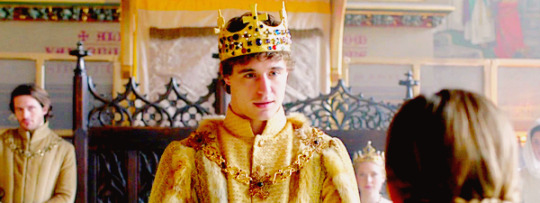
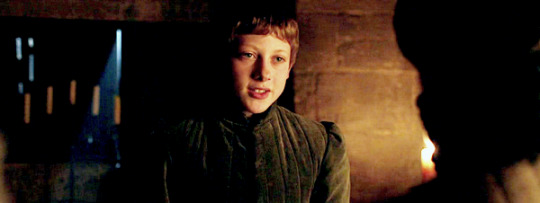

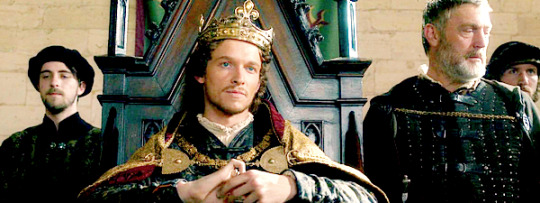
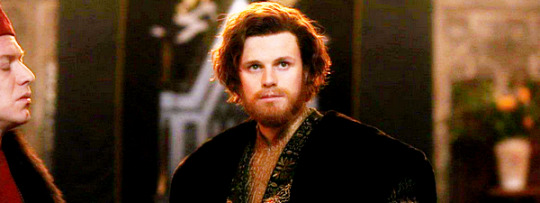
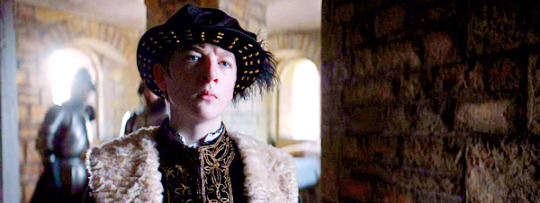
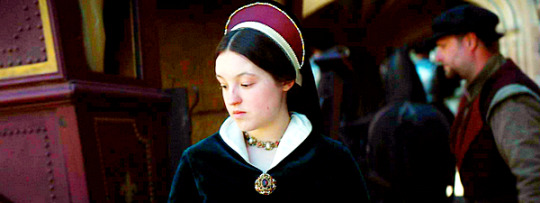




KINGS & QUEENS REGNANT OF ENGLAND ACCORDING TO STARZ
Henry VI (1 September 1422 - 4 March 1461, 3 October 1470 - 11 April 1471 second reign) as portrayed by David Shelley in The White Queen
Edward IV (4 March 1461 - 3 October 1470, 11 April 1471 - 9 April 1483 second reign) as portrayed by Max Irons in The White Queen
Edward V (9 April 1483 - 25 June 1483) as portrayed by Sonny Ashbourne Serkis in The White Queen
Richard III (26 June 1483 - 22 August 1485) as portrayed by Aneurin Barnard in The White Queen
Henry VII ( 22 August 1485 - 21 April 1509) as portrayed by Jacob Collins-Levy in The White Princess
Henry VIII (22 April 1509 - 28 January 1547) as portrayed by Ruairi O'Connor in The Spanish Princess
Edward VI (28 January 1547 - 6 July 1553) as portrayed by Oliver Zetterstrom in Becoming Elizabeth
Jane Grey (10 July 1553 - 19 July 1553) as portrayed by Bella Ramsey in Becoming Elizabeth
Mary I (19 July 1553 - 17 November 1558) as portrayed by Romola Garai in Becoming Elizabeth
Elizabeth I (17 November 1558 - 24 March 1603) as portrayed by Alicia Von Rittberg in Becoming Elizabeth
James I and VI of Scotland (24 March 1603 - 27 March 1625) as portrayed by Tony Curran in Mary & George
Charles I (27 March 1625 - 30 January 1649) as portrayed by Samuel Blenkin in Mary & George
#perioddramaedit#the white queen#the white princess#the spanish princess#becoming elizabeth#mary and george#my edits#twqedit#twpedit#thespanishprincessedit#becomingelizabethedit#maryandgeorgeedit#david shelley#max irons#sonny ashbourne serkis#aneurin barnard#jacob collins levy#ruairi o'connor#oliver zetterstrom#bella ramsey#romola garai#alicia von rittberg#tony curran#samuel blenkin#henry vi#edward iv#edward v#richard iii#henry vii#henry viii
203 notes
·
View notes
Text
The Shadohunter Chronicles Character Showdown
First Round, Second Round
Rosemary Herondale vs Arthur Blackthorn, (Feb 23)
Celine Montclaire vs Diego Rocio-Rosales, (Feb 24)
Maureen Brown vs Anna Lightwood, (Feb 25)
Christopher Lightwood vs Ragnor Fell, (Feb 26)
Julian Blackthorn vs Livvy Blackthorn, (Feb 27)
Bridget Daly vs Jon Cartwright, (Feb 28)
Nate Grey vs Sona Carstairs, (Feb 29)
Gabriel Lightwood vs Madeleine Bellefleur, (Mar 1)
Paige Ashdown vs Rupert Blackthorn, (Mar 2)
Valentine Morgenstern vs Kraig, (Mar 3)
Andrew Blackthorn vs Irene, (Mar 4)
Axel Mortmain vs Thais Pedroso, (Mar 5)
Kit Herondale vs Ke Yi Tian, (Mar 6)
The Dark Sisters vs Filomina di Angelo, (Mar 7)
Lucie Herondale vs Simon Lovelace-Lewis, (Mar 8)
Shiyun Jung vs Cameron Ashdown, (Mar 9)
Elias Carstairs vs Tavvy Blackthorn, (Mar 10)
Luke Greymark vs Will Herondale, (Mar 11)
Ash Morgenstern vs Matthew Fairchild, (Mar 12)
Sophie Collins vs Jaime Rocio-Rosales, (Mar 13)
Catarina Loss vs Tessa Grey, (Mar 14)
Jessamine Lovelace vs Woolsey Scott, (Mar 15)
Diana Wrayburn vs Magnus Lightwood-Bane, (Mar 16)
James Herondale vs Jesse Blackthorn, (Mar 17)
Sebastian Morgesnstern vs Ty Blackthorn, (Mar 18)
Julie Beavul vs Tatiana Lightwood, (Mar 19)
Meliorn vs Helen Blackthorn, (Mar 20)
Alexander Lightwood vs Arawn, (Mar 21)
Jace Lightwood-Herondale vs Michael Wayland, (Mar 22)
Raphael Santiago vs Kieran Kingson, (Mar 23)
Marisol Garza vs Hypatia Vex, (Mar 24)
Dru Blackthorn vs Ari Bridgstock, (Mar 25)
Eugenia Lightwood vs Bat Velasquez, (Mar 26)
Eliza Rosewain vs Rafael Lightwood-Bane, (Mar 27)
Anush Joshi vs Seelie Queen, (Mar 28)
Church vs Cecily Herondale, (Mar 29)
Annabel Blackthorn vs Robert Lightwood, (Mar 30)
Beatriz Mendoza vs Malcolm Fade, (Mar 31)
Jocelyn Fairchild vs Max Lightwood-Bane, (Apr 1)
Imogen Whitlaw vs Jem Carstairs, (Apr 2)
Mother Hawthorn vs Chairman Meow, (Apr 3)
Manuel Casales-Villalobos vs Barbra Lightwood, (Apr 4)
Cordelia Carstairs vs Benedict Lightwood, (Apr 5)
Divya Joshi vs Lily Chen, (Apr 6)
Patrick Penhallow vs Alastair Carstairs, (Apr 7)
Isabelle Lightwood vs Mark Blackthorn, (Apr 8)
Amatis Greymark vs George Lovelace, (Apr 9)
Maryse Lightwood vs Elliott, (Apr 10)
Alexei de Quincey vs Elyas the Demon, (Apr 11)
Hodge Starkweather vs Henry Branwell, (Apr 12)
Camille Belcourt vs Auraline, (Apr 13)
Aline Penhallow vs Roland Loss, (Apr 14)
Johny Rook vs Stephen Herondale, (Apr 15)
Rayan Maduabuchi vs Alec Lightwood-Bane, (Apr 16)
Esme Hardcastle vs Jordan Kyle, (Apr 17)
Grace Blackthorn vs Evelyn Highsmith, (Apr 18)
Jia Penhallow vs Charles Fairchild, (Apr 19)
Horace Dearborn vs Max Lightwood, (Apr 20)
Emma Carstairs vs Mina Carstairs, (Apr 21)
Charlotte Fairchild vs Aloysius Starkweather, (Apr 22)
Janus Herondale vs Zachary Carstairs, (Apr 23)
Gwyn ap Nudd vs Clary Fairchild, (Apr 24)
Maia Roberts vs Gideon Lightwood, (Apr 25)
Thomas Lightwood vs Cristina Mendoza-Rosales, (Apr 26)
#shadowhunters#the shadowhunter chronicles#tsc#the dark artifices#tda#the mortal instruments#tmi#the last hours#tlh#the wicked powers#twp#tid#the infernal devices#Shadowhunter Character Showdown 2024#Its back with more charcters then ever#*cries in a corner despiet knowing I brought this on myself*#I'll update with links as it goes along liek always
30 notes
·
View notes
Text
THIS DAY IN GAY HISTORY
based on: The White Crane Institute's 'Gay Wisdom', Gay Birthdays, Gay For Today, Famous GLBT, glbt-Gay Encylopedia, Today in Gay History, Wikipedia, and more … May 21
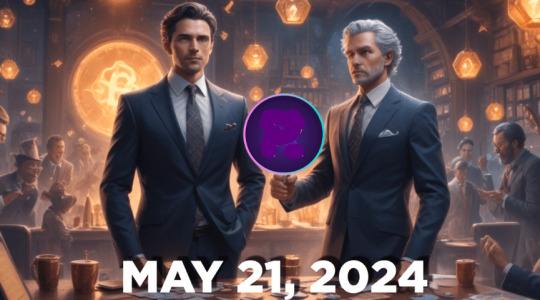


1857 – Count Albrecht Friedrich Wilhelm Bernhard of Hohenau, born in the Albrechtsberg Castle in Dresden (d.1914) was a German nobleman.
Friedrich, also known as Fritz, was a son of Prince Albrecht of Prussia, who was a brother of Emperor William I and King Frederick William IV of Prussia, from his second, morganatic marriage with Rosalie, daughter of the Prussian War Minister Gustav von Rauch. Because his father's marriage to his mother was morganatic, Friedrich was not counted as a member of the House of Hohenzollern.
After the death of his mother, Friedrich was, together with his older brother, William, heir to the Schloss Albrechtsberg in Dresden, which he occupied until his death. In 1901, together with Friedrich Botho, a brother of Philip, Prince of Eulenburg, he had to leave the Prussian military service because of his homosexual inclinations.
Friedrich was also involved in the two biggest scandals of the German Empire under Kaiser Wilhelm II. He belonged to the Liebenberg Round Table – a circle of homosexual associates of the Kaiser – and played a role alongside his wife in the so-called Kotze Affair – a series of anonymous letters full of obscene accusations sent to prominent Gremans.

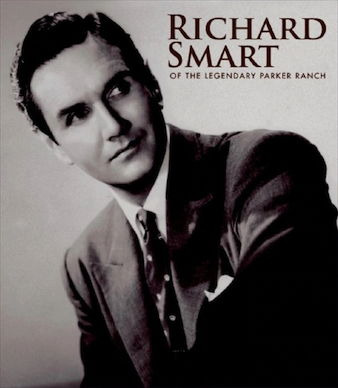
1913 – Richard Smart (d.1992) was a musical theatre actor and singer who became owner of the largest private ranch in Hawaii.
Richard Palmer Kaleioku Smart was born in Honolulu. In 1914 the family traveled to Europe, where his mother gave birth to a sister Elizabeth Ella Smart in Paris. By this time World War I was starting, so they hurriedly traveled back to New York City, where the sister died. His mother died shortly after this from tuberculosis. A year later, his father Henry Gaillard Smart (son of a Virginia clergyman) died. He was raised by his part-Hawaiian maternal grandmother, born Elizabeth Jane Lanakila Dowsett, usually called "Aunt Tootsie" in San Francisco. Smart was sent to Los Gatos High School and become interested in theater.
Although he had many cousins, he became the sole owner of the Parker Ranch on Hawaiʻi Island, founded by his 5th generation ancestor John Palmer Parker (1790–1868). The ranch was managed by Alfred Wellington Carter. Already one of the largest owned by a single person (the King Ranch was owned by a corporation), the Carters expanded the operation further through the 20th century. The ranch had over 500,000 acres (200,000 ha) of land and 30,000 head of Hereford cattle.
Smart became a nightclub singer and performed in plays and musicals from 1933–1939. Director Joshua Logan hired him for the Broadway theatre production of Two for the Show in 1940, and he performed in The Merry Widow. Smart married actress Patricia Monteagle who appeared un-credited in the 1936 movie The Great Ziegfeld, but was more well known as a socialite. The family moved to Honolulu later in 1940, but then lived in California after the Attack on Pearl Harbor. About 40,000 acres (16,000 ha) of the ranch were leased to the United States Marines for use as Camp Tarawa.
He was divorced in 1944.
After the war he appeared under the name Dick Smart. In 1946 and 1947, he starred in the Broadway production of Bloomer Girl with Nanette Fabray and All for Love in 1949. Over nearly 30 years, Smart performed on Broadway and in cabarets in the U.S. and abroad. He headlined such clubs as the Coconut Grove in Los Angeles, the Monte Carlo in New York and Le Lido in Paris. After A.W. Carter died in 1949, Smart took a more active role in the ranch.Despite having married and fathered two children, there is reason to believe Smart was homosexual or at least bisexual. His marriage ended in a divorce in 1944 and he never remarried. George W. Parker III, wrote he learned Smart was gay via a mutual acquaintance, who told him "Smart was gay" at least while she knew him when he was living on the French Riviera. A Hawaii Island resident wrote "Smart who died in the last few years was gay. He was very progressive and did wonders for the Big Island helping the poor folks out some." On this same forum in reply another Hawaii resident in September 2009 wrote "I knew Richard Smart was gay."


1917 – Today is the birthday in New Westminster, British Columbia of Raymond Burr, Canadin-American actor best known for his "Perry Mason" lawyer roles. (d.1993) Early in his career Burr invented fictional wives and a son (and in some cases their fictional deaths) to throw reporters off the scent of his real life. Fortunately for Burr, he found some peace towards the end of his life with his longtime companion Robert Benevides (b. 1930), who was Burr's "long-time companion" for 30 years until the actor's death.

Raymond Burr and Robert Benvenides
Burr met Benevides, a young actor and Korean War veteran on the set of Perry Mason in the mid 1950s, . According to Benevides they became a couple about 1960 and he gave up acting in 1963 and later became a production consultant for 21 of the Perry Mason TV movies. Together they owned and operated an orchid business and then a vineyard, in the Dry Creek Valley. He said he was Burr's partner until Burr's death in 1993. Burr left Benevides his entire estate, including "all my jewelry, clothing, books, works of art,...and other items of a personal nature." Benevides remains the proprietor of the vineyard they created together in Healdsburg, California.
Later accounts of Burr's life explain he hid his sexuality to protect his career. In 2000, AP reporter Bob Thomas recalled the situation:
It was an open secret...that he was gay. He had a companion who was with him all the time. That was a time in Hollywood history when homosexuality was not countenanced. Ray was not a romantic star by any means, but he was a very popular figure...if it was revealed at that time in Hollywood history [that he was gay] it would have been very difficult for him to continue.
Art Marks, a producer of Perry Mason, recalled Burr's talk of wives and children: "I know he was just putting on a show....That was my gut feeling. I think the wives and the loving women, the Natalie Wood thing, were a bit of a cover."
In 2006, Dean Hargrove, who worked on Perry Mason Returns, said:
"I had always assumed that Raymond was gay, because he had a relationship with Robert Benevides for a very long time. Whether or not he had relationships with women, I had no idea. I did know that I had trouble keeping track of whether he was married or not in these stories. Raymond had the ability to mythologize himself, to some extent, and some of his stories about his past...tended to grow as time went by."
A 2007 memoir by actor Paul Picerni described several experiences with Burr about 1951 on the set of A Place in the Sun, when he felt Burr expressed sexual interest in him. He wrote:
"I saw him staring at me. With his big blue eyes. And with this strange expression on his face. For the first time in my life, I felt like a DAME. Then it hit me: He'd been giving me all this bullshit about his wife and his two kids in London, when in fact he was gay, and he was makin' a move on me!" [Burr] "was a great guy and very subtle in his homosexuality."
Burr had many hobbies over the course of his life: cultivating orchids, collecting wine, art, stamps, and seashells. He was interested in cooking, flying, sailing, and fishing. He donated most of his money to charities and friends. According to A&E Biography, Burr was also an avid reader with a retentive memory. In addition, he taught acting classes at Columbia University. He was also among the earliest importers and breeders of Portuguese Water Dogs in the United States. Burr was devoted to his favorite hobby, cultivating and hybridizing orchids.
He, Michael J. Fox and Jim Carrey head list of top Canadians in U.S. television compiled by Banff Television Festival, June 2002. In 2008 he was among four Canadians commemorated on stamps of Canada. (The other 3 were Norma Shearer, Marie Dressler and Chief Dan George.) Before dying from cancer, he threw some grand parties to say farewell to many of his friends. After dying of cancer, he was interred at Fraser Cemetery, New Westminister, British Columbia, Canada.

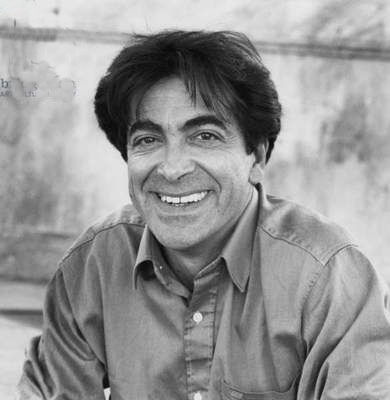
1948 – French author Patrick Drevet has earned distinction for his vividly sensual and at times unsettling depictions of the natural world, individual subjectivity, and homosexual attraction.
He was born in Saint-Etienne, France; son of Antoine a lumber salesman and Marie, a secretary.
Regarded as an accomplished literary stylist, Drevet's meticulously descriptive prose has been compared to that of s Alain Robbe-Grillet, while his focus on homosexual longing has elicited comparison to the works of Marcel Proust, Arthur Rimbaud, and André Gide. In a review of Drevet's 2003 book, Paysages d'Eros, Lambda Book Report reviewer Benjamin Ivry identified Drevet as an important gay writer whose oeuvre is long overdue for English-language translation.
Le gour des abeilles relates the adventure of two boys who find spiritual transformation at a remote gorge on the Bienne River. Forbidden by their mothers to embark on the expedition, the boys are enlivened by their rebellion and the erotic reputation of their destination, where they hope to spy muscular swimmers and couples in the surrounding woods.
Le visiteur de hasard is a journal in which an unnamed schoolteacher recounts his growing fascination with one of his students, Jean-Louis S. The teacher, who is married and a father, is irresistibly drawn to the boy's adolescent physicality. Sensing that the boy is strangely different from his peers, the teacher eventually learns that he has fled his home and lives alone, apparently supporting himself through prostitution. As their relationship intensifies, the teacher becomes the student, and they finally consummate their mutual seduction in an impassioned liaison.
Une chambre dans les bois centers upon the relationship between a fatherless young boy named David and a mysterious older youth named William, whom David encounters while working with a group of Italian woodcutters in the Jura Mountains. William initially avoids David, but in light of David's deep admiration he eventually warms to the young boy and they become friends. The novel is set during the 1950s against the background of the Algerian War; William reveals to David that he is a deserter from the French military, thus explaining his presence at the remote lumber camp. David's platonic affection for William gradually becomes physical, and they finally sleep together while William is hiding out at David's home.
Drevet is also the author of film scripts, plays for children, and television productions, and a contributor to periodicals, including Magazine littéraire, Moule à gaufres, Nouvelles nouvelles, and Quai Voltaire revue littéraire.

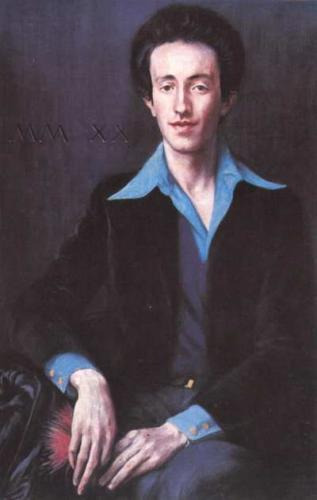
1952 – Mario Mieli (d.1983) was a leading figure in the Italian gay movement of the 1970s. He combined a radical theoretical perspective with a provocative public persona. His sometimes outrageous public behavior made him a controversial figure, but he was nonetheless respected as one of the movement's most important intellectuals. He's best known among English speakers for Towards a Gay Communism, a political pamphlet excerpted from his major theoretical work Homosexuality and Liberation: Elements of a Gay Critique.
Mieli was born into a large and prosperous family. He lived for the first sixteen years of his life on his family's estate near Como. Mario moved back to Milan with his family in 1968. Politically precocious, he threw himself into the student uprising of that year, beginning a long commitment to revolutionary causes.
In 1971 he moved to London as a student, where he took an active part in the London Gay Liberation Front. Though he spent intermittent time in London until 1975, in 1972 based himself in Milan where he studied at university. In April 1972, he, along with others, held the first homosexual demonstration in Italy at a Congress of Sexology in San Remo. They protested against psychiatric condemnation of homosexual conduct and the use of aversion therapy to "convert" homosexuals.
In 1972, Mieli helped found the collective Fronte Unitario Omosessuale Rivoluzionario Italiano (Italian revolutionary homosexual united front). Better known by its acronym F.U.O.R.I! (Come out!), it was Italy's first major gay-rights group. Started in Turin in 1971, F.U.O.R.I! appeared almost simultaneously in Rome, Padua, Venice and in Milan, where Mieli was an organizer.
A controversial personality, Mieli sometimes made a spectacle of himself. Once in Rome he publicly ate his own excrement and that of a dog. While some may have found this behavior outrageous or frightening, others knew him as a gentle person who enjoyed cross-dressing, capable of being very charming in private.
His doctoral thesis was published as Elementi di critica omosessuale. An English translation of the book was made by David Fernbach as Homosexuality and Liberation: Elements of a Gay Critique. The translation's last chapter - "Towards a Gay Communism" - was excerpted as a political pamphlet and became Mieli's most widely known work among English speakers.
By 1981, Mieli became increasingly pessimistic about his cause. In 1983, he told friends about a forthcoming book titled Il risveglio dei Faraoni (The Awakening of the Pharaohs). It was to be an autobiographical novel, set in Egypt featuring a resurrected Jesus. But in early March, he decided to stop publication of the book, writing in a letter to a friend that the book might inspire someone to "have his hide". In another letter dated March 11, he wrote "My book will not be published by my free choice". Mario Mieli killed himself the following day, on March 12, 1983. He died at age 30 from asphyxiation by inhaling gas in his Milan apartment. It seems that Mieli's suicide stemmed from adverse reaction he expected from the book's publication. Although a pirated edition was later published, his family brought legal action and had all copies destroyed. Only in 1994 was Il risveglio dei Faraoni published legally.


1953 – Bill Yosses was born on this date and was, from January 2007 until June of 2014, the White House Executive Pastry Chef. Yosses was the successor to Thaddeus DuBois who left the same position in 2006. He served as a White House Holiday Pastry Chef for the 2006 holiday season. He was hired to the position by First Lady Laura Bush.
His most recent project has been to assist in the opening of Paul Newman's Dressing Room in Westport, Connecticut–a restaurant using locally grown, artisanal and organic food sources. Other Executive Pastry Chef experience includes Joseph's Citarella in New York City; planning, designing and opening the pastry department of Bouley Restaurant and Bakery and operating the pastry department of the Tavern on the Green Restaurant in New York City. Mr. Yosses was also Pastry Chef at Montrachet Restaurant in New York City. He is the coauthor of the book Desserts for Dummies.
Yosses served apprenticeships in France, and also worked under Chefs Daniel Boulud and then Sous Chef Thomas Keller at Polo Restaurant in New York City. He earned his A.A.S. degree at the New York City College of Technology in Hotel Management, a Master of Arts at Rutgers University in French Language and Literature and a Bachelor of Arts at the University of Toledo in French Language.
President Barack Obama says of Yosses, "Whatever pie you like, he will make it and it will be the best pie you have ever eaten." Obama nicknamed Yosses "the Crust Master."
In March 2014, Yosses announced that he will resign the White House position effective June 2014, leaving the position to work on a new project focusing on "food literacy" by teaching young children and adults about eating better.
Mr. Yosses, 60, said he was also moving to New York to be with his husband, Charlie Jandusay Fabella Jr., a teacher. The two married in Washington in 2011, but "for the eleven years my husband and I have known each other, we have lived in different cities," Mr. Yosses said.

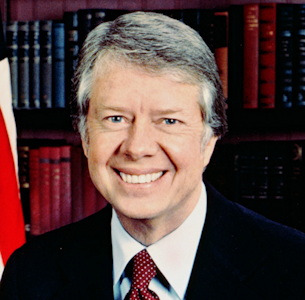
1976 – Candidate Jimmy Carter announces that if elected he will support and sign a federal civil rights bill outlawing discrimination against gays and lesbians.


1996 – Hungary legalized same-sex civil unions, becoming the first ex- communist country and the 5th country worldwide to do so. The Parliament voted 207-73 in favor of the Bill.


1994 – (Thomas Robert) Tom Daley is an English diver and television personality. Daley specialises in the 10 metre platform event and was the 2009 FINA World Champion in the individual event at the age of 15. He started diving at the age of seven and is a member of Plymouth Diving Club. He has made an impact in national and international competitions from age 9. He represented Great Britain at the 2008 Summer Olympics where he was Britain's youngest competitor, the youngest competitor of any nationality outside the sport of swimming, and the youngest to participate in a final. In 2009, Daley reached a career best ranking of number one in the FINA World Diving Rankings for the ten-metre platform.
He won two gold medals for England at the 2010 Commonwealth Games, in the 10 metre synchro diving (with Max Brick) and the 10 m Individual Platform competition, and won the bronze medal for Great Britain in the individual competition at the 2012 Summer Olympic Games.
After his success at the 2012 Olympic Games and a summer of great sporting interest amongst the public in the UK, television network ITV approached Daley to have a role in their new celebrity diving reality TV show Splash!. Daley made his debut in the show's premiere on 5 January 2013 as a mentor to the celebrity competitors taking part.
On 2 December 2013, Daley released a YouTube video announcing that he had been in a relationship with a man since early that year. He said: "I've never been happier." Daley said that it had been a tough decision to speak out about his private life. He said: "I'd never felt the feeling of love, it happened so quickly, I was completely overwhelmed by it to the point I can't get him out of my head all the time." His partner is American film screenwriter, director and producer Dustin Lance Black. They live together in London.
In 2014, Daley was number 3 on the World Pride Power list. Daley has made some conflicting statements in regards to his sexual orientation. After his YouTube video appearance he stated, "I am a gay man now". But later, when asked by The Guardian, in a July 2015 interview, if he was bisexual, Daley said: "I don't put a particular label on any of it because right now I’m in a relationship with a guy, but I still have sexual feelings towards girls." When asked about his coming to terms with his same-sex attraction and his relationship with Black, he said that while he has always been attracted to guys, and that "it has always been in the back of my head... I’d never had feelings for a person along those lines. I’d been in relationships with girls where I’d had sexual feelings, but it became so much more intense when I met Lance."
On 1 October 2015, it was announced in The Times that Daley and Black were engaged. The announcement, in the Births, Marriages and Deaths section read: "The engagement is announced between Tom, son of Robert and Debra Daley of Plymouth, and Lance, son of Jeff Bisch of Philadelphia and Anne Bisch of Lake Providence." The couple married in May of 2017.


2013 – Nepal: Cason Crane becomes the first openly gay man to summit Mt. Everest. He does it as part of his Rainbow Summit Project to raise awareness for the Trevor Project. In 2013, he became the first gay mountaineer to scale the Seven Summits.


15 notes
·
View notes
Note
Has there ever been a time when we haven't had a vice president?
John Adams was sworn in as our first Vice President in 1789 and in the 234 years since then, we've gone without a VP for 37 years and 290 days.
Until the ratification of the Twenty-Fifth Amendment, there was no mechanism for filling a vacancy in the Vice Presidency, so in several instances we've gone almost entire Presidential terms without a Vice President.
7 Vice Presidents Died In Office:
•George Clinton (Jefferson's second VP & Madison's first VP), died April 20, 1812, leaving the Vice Presidency vacant for 318 days.
•Elbridge Gerry (Madison's second VP), died November 23, 1814, leaving a vacancy for 2 years, 101 days.
•William Rufus DeVane King (Pierce's VP), died April 18, 1853, leaving a vacancy for 3 years, 320 days.
•Henry Wilson (Grant's second VP), died November 22, 1875, leaving a vacancy for 1 year, 102 days.
•Thomas A. Hendricks (Cleveland's first VP), died November 24, 1885, leaving a vacancy for 3 years, 99 days.
•Garret A. Hobart (McKinley's first VP), died November 21, 1899, leaving a vacancy for 1 year, 103 days.
•James S. Sherman (Taft's VP), died October 30, 1912, leaving a vacancy for 125 days.
2 Vice Presidents Resigned:
•John C. Calhoun (VP under John Quincy Adams and Jackson's first VP), resigned on December 28, 1832, leaving a vacancy for 66 days.
•Spiro Agnew (Nixon's first VP), resigned on October 10, 1973, leaving a vacancy for 57 days.
9 Vice Presidents Succeeded to the Presidency:
•John Tyler (William Henry Harrison's VP), assumed office upon President Harrison's death on April 4, 1841, leaving a VP vacancy for 3 years, 333 days.
•Millard Fillmore (Taylor's VP), assumed office upon President Taylor's death on July 9, 1850, leaving a VP vacancy for 2 years, 238 days.
•Andrew Johnson (Lincoln's second VP), assumed office upon President Lincoln's death on April 15, 1865, leaving a VP vacancy for 3 years, 323 days.
•Chester Arthur (Garfield's VP), assumed office upon President Garfield's death on September 19, 1881, leaving a VP vacancy for 3 years, 166 days.
•Theodore Roosevelt (McKinley's second VP), assumed office upon President McKinley's death on September 14, 1901, leaving a VP vacancy for 3 years, 171 days.
•Calvin Coolidge (Harding's VP), assumed office upon President Harding's death on August 2, 1923, leaving a VP vacancy for 1 year, 214 days.
•Harry S. Truman (FDR's third VP), assumed office upon President Roosevelt's death on April 12, 1945, leaving a VP vacancy for 3 years, 283 days.
•Lyndon B. Johnson (JFK's VP), assumed office upon President Kennedy's death on November 22, 1963, leaving a VP vacancy for 1 year, 59 days.
•Gerald Ford (Nixon's second VP), assumed office upon President Nixon's resignation on August 9, 1974, leaving a VP vacancy for 132 days.
Only two Vice Presidential vacancies have been filled under the provisions of the 25th Amendment. Gerald Ford was appointed to the Vice Presidency by President Nixon following Spiro Agnew's resignation in October 1973 and was confirmed by Congress in December 1973 (a nominee to fill a Vice Presidential vacancy must be confirmed separately by a majority vote of both chambers of Congress). On August 9, 1974, Nixon resigned as President and Ford succeeded to the White House, leaving the Vice Presidency vacant for the second time in less than a year. President Ford nominated Nelson Rockefeller as Vice President on August 20 and he was confirmed by Congress in December 1974.
#History#Vice Presidency#Vice President of the United States#Vice Presidents#Vice Presidential Vacancies#Constitution#Twenty-Fifth Amendment#Vice Presidential nominees#VPs#VPOTUS#Vice Presidential History#Presidents#Presidency#Presidential History#Presidential Succession
33 notes
·
View notes
Photo
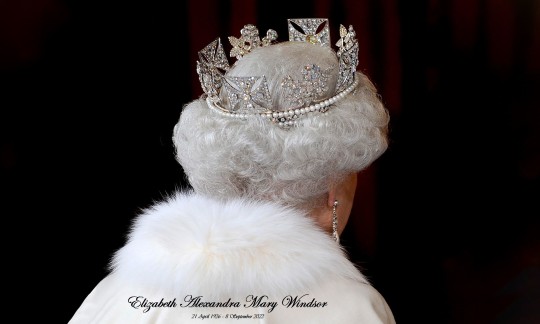
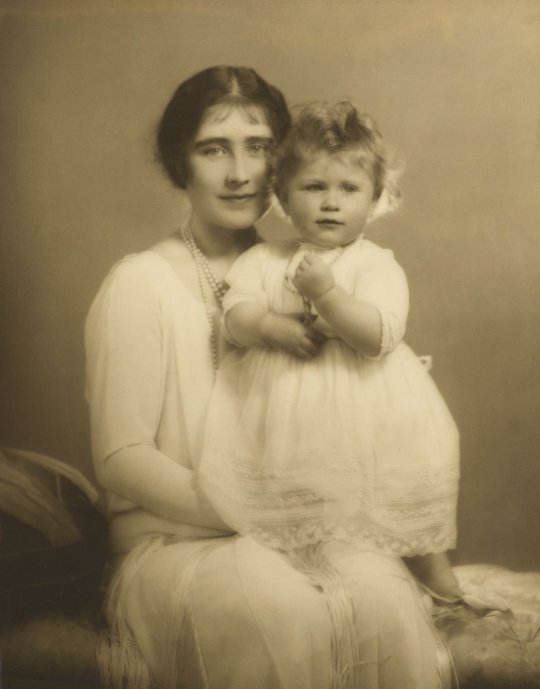


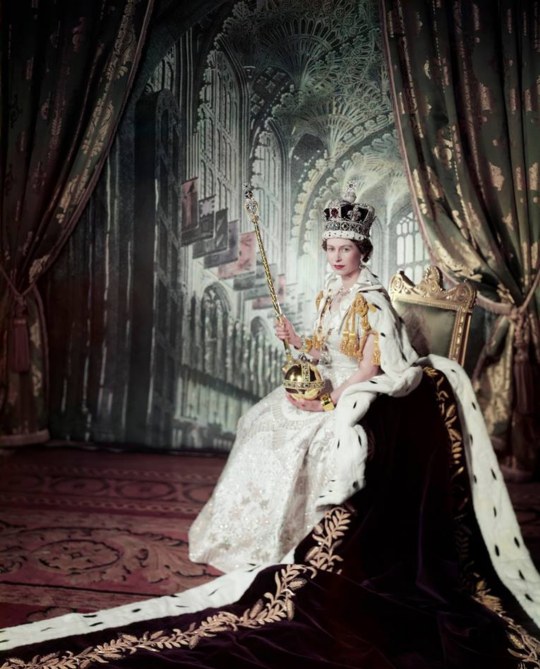
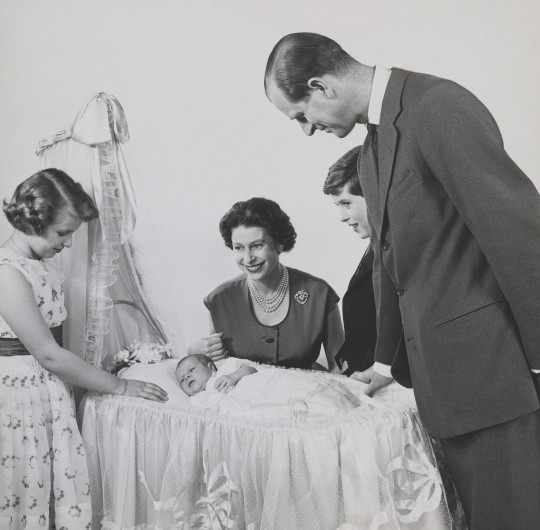


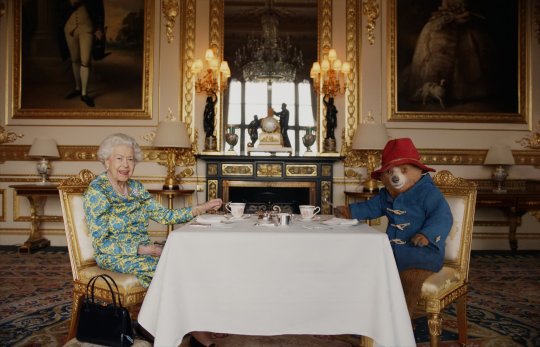

Queen Elizabeth II has died
Queen Elizabeth II, the United Kingdom’ s longest-serving monarch, has died at Balmoral aged 96, after reigning for 70 years.
Elizabeth II (Elizabeth Alexandra Mary; 21 April 1926 – 8 September 2022) was Queen of the United Kingdom and 14 other Commonwealth realms from 6 February 1952 until her death on 8 September 2022.
Her reign of 70 years and 214 days was the longest of any British monarch and the second longest recorded of any monarch of a sovereign country.
Elizabeth was born in Mayfair, London, as the first child of the Duke and Duchess of York (later King George VI and Queen Elizabeth). Her father acceded to the throne in 1936 upon the abdication of his brother, King Edward VIII, making Elizabeth the heir presumptive.
She was educated privately at home and began to undertake public duties during the Second World War, serving in the Auxiliary Territorial Service. In November 1947, she married Philip Mountbatten, a former prince of Greece and Denmark, and their marriage lasted 73 years until his death in April 2021. They had four children together: Charles III; Anne, Princess Royal; Prince Andrew, Duke of York; and Prince Edward, Earl of Wessex.
When her father died in February 1952, Elizabeth—then 25 years old—became queen regnant of seven independent Commonwealth countries: the United Kingdom, Canada, Australia, New Zealand, South Africa, Pakistan, and Ceylon (known today as Sri Lanka), as well as Head of the Commonwealth. Elizabeth reigned as a constitutional monarch through major political changes such as the Troubles in Northern Ireland, devolution in the United Kingdom, the decolonization of Africa, and the United Kingdom's accession to the European Communities and withdrawal from the European Union.
The number of her realms varied over time as territories have gained independence and some realms have become republics. Her many historic visits and meetings include state visits to China in 1986, Russia in 1994, the Republic of Ireland in 2011, and visits to or from five popes.
Significant events include Elizabeth's coronation in 1953 and the celebrations of her Silver, Golden, Diamond, and Platinum Jubilees in 1977, 2002, 2012, and 2022, respectively.
Elizabeth was the longest-lived and longest-reigning British monarch, the oldest and longest-serving incumbent head of state, and the second-longest verifiable reigning sovereign monarch in world history, only behind Louis XIV of France.
She faced occasional republican sentiment and media criticism of her family, particularly after the breakdowns of her children's marriages, her annus horribilis in 1992, and the death of her former daughter-in-law Diana, Princess of Wales, in 1997.
However, support for the monarchy in the United Kingdom remained consistently high, as did her personal popularity. Elizabeth died on 8 September 2022 at Balmoral Castle, Aberdeenshire.
“The Queen is dead, Long live King Charles III”
The Duchess of York with Princess Elizabeth, 30 June 1927 by Marcus Adams (The Royal Collection Trust),
Princess Elizabeth in uniform (1942) by Cecil Beaton (The Royal Collection Trust),
Princess Elizabeth and The Duke of Edinburgh on their wedding day, 20th November 1947 by Sterling Henry Nahum ‘Baron’ (The Royal Collection Trust),
Queen Elizabeth II poses on her Coronation Day on June 2, 1953, in London (Photography by Cecil Beaton),
Queen Elizabeth II with Prince Philip, Duke of Edinburgh and family - 16 Mar 1960 by Cecil Beaton (From the Collection of Queen Elizabeth The Queen Mother),
Queen Elizabeth II and her son, the Prince of Wales, out riding at Windsor Castle I May 18, 1961 (PA),
The Royal coat of arms of the United Kingdom used outside of Scotland,
Queen Elizabeth II Platinum Jubilee 2022 - Platinum Party At The Palace. The Queen Elizabeth II and Paddington Bear having cream tea at Buckingham Palace (BBC Platinum Party at the Palace),
Portrait of Queen Elizabeth II released by The Royal Windsor Horse Show on April 20, 2022 to mark the occasion of her 96th birthday.
#rip#queen elizabeth ii#elizabeth II#queen elizabeth#monarchy#united kingdom#royal#platinium junilee#windsor#markus adams#cecil beaton#theroyalcollectiontrust#paddington#bbc#balmoral#diana#king charles III#princess anne#prince andrew#prince edward#liveunique#history#britsh history#british royality
345 notes
·
View notes
Text
Yet another another another excerpt from I Survived Kirk, the forthcoming fanfic autobiography of a bitter redshirt on Kirk's Enterprise
I may be a former member of Starfleet, but that doesn’t mean I agree with every choice they make or have made in the past. Starfleet is STILL paying for the mistakes they made in early missions, and likely will for centuries to come.
I hate propaganda. I hate whitewashing history. Don’t teach lies so that your children won’t have to learn that you’re flawed and made stupid mistakes, otherwise they’ll make the same damn ones. Obviously, I wasn’t there but if you do the research you can verify all this for yourself.
We’re taught that Jonathan Archer heroically saved the planet from the Xindi in 2153. We’re told he was instrumental in ending the Romulan war. He was a hero, who paved the way for the United Federation of Planets. He’s a legend.
But here’s what they don’t tell you: Jonathan Archer wasn’t even the first choice to command Enterprise NX-01. That was a guy named AG Robinson, who was disqualified after an unauthorized test flight. Something HUGE that is ALWAYS glossed over, is the fact that it was Jonathan Archer’s father Henry Archer who designed the Enterprise’s warp five engine. Nepotism in Starfleet? The same nepotism that pervades today, if anyone looks up George Kirk Sr, best friend of Captain Robert April and whose troublemaker of a son ended up succeeding April (and Pike) as captain of this generation’s USS Enterprise.
And it’s not like Archer had any starship experience. That’s why you never hear about his time on any ships before Enterprise. There wasn’t any. “Flight School” (that’s what came before Starfleet Academy) – test pilot of the NX-project – Captain of the Enterprise. They just declared him a captain and sent him out in charge of 80-odd people.
It was Jonathan Archer that invited the infamous Xindi attack which cost 7 million lives and destroyed Florida by telling every alien they encountered for two years how to find Earth. He literally sent starcharts so that even the ones that couldn’t understand our language knew where we came from.
And Starfleet just let him. In fact, they didn’t even send Enterprise out with a proper mission statement except to “go where no man has gone before”. You’d think a mission of such import (they only spent 30 years developing the warp five engine and ship design, which ended up the blueprint for everything after upto and including our current generation of starships), they’d have mapped out the mission in intricate detail, which stars to visit, which planets to chart, which aliens to contact and what to say/not say. But no, Johnny boy just floated around aimlessly, getting his ship into trouble and making a professional victim of himself. He was “officially” kidnapped 28 times between April 26, 2151 and April 24, 2153. Once he caused an intergalactic incident because he let his dog piss up some sacred tree. Once he almost let member of his crew die in the extreme heat of a planet and never thought to beam down cooling units. Most infamously, he refused medical help to a species called the Valakians because he decided it was their destiny to die out. What a nice man.
So anyway, after two years of obliviously causing intergalactic incidents (including with the Romulans, more on that later), a race called the Xindi sent a weapon to Earth and killed 7 million people. They then build and launch a second, much larger weapon to destroy the entire planet (because just rendering it uninhabitable is too mainstream, or something. I guess these guys weren’t the sharpest knives in the drawer either). Archer somehow sneaks onto the weapon and destroys it, and somehow survives.
Now, why did the Xindi attack? Something to do with ancient gods but they’re very sorry now can we join the Federation blah blah. How did the Xindi attack? Earth was clearly marked in maps the Enterprise had been transmitting to everyone they encountered. Why advertise your location to a galaxy full of clearly hostile species without adequate defences?
And yes, Archer’s why the Klingons and Romulans hate us, too. Cheers mate, you’re a legend.
27 notes
·
View notes
Text
Nancy Drew Season 4 Trailer Part 4
I’m back with another obsessive breakdown of the 30 seconds of mayhem that is the S4 trailer. Part 1, Part 2, Part 3 here. My method of madness - connect the dots with all of the behind the scenes content, social posts, podcasts, and articles to figure out a possible episode and any context we can glean about what the heck is going on. Remember it’s all still speculation so please don’t come back and tell me how wrong I was later (but feel free to tell me when I was right 😀).
Next up we have demons! Love this enhanced reaction shot from @nancydrewgifs’s gif on the bird app.

Much to discuss. From Ace and George’s wardrobe (and hair), this looks like Episode 5 - this is the episode featured in the official season announcement, directed by Scott Wolf, and with lots of cool scenes shared by Kennedy like this one and this one.


We have two other visual clues that make it more complicated. Bess is wearing her hair up like she wears with the sexy business dress w/name tag (as well as the official promo shot in the white blouse), and she’s got on the black and white coat from this blue screen scene.


And then Kennedy is wearing (I think) this super hot black dress under the blue denim jacket from the same timeframe. That last shot is from DP Nick Thomas - another woods scene that could be from Ep. 5 based on the timing (with stand-ins).


So Episode 5 (if all of this is Ep. 5) has a confrontation in the woods with a demon, a scene in the Claw with some kind of function that requires a name tag (a singles mixer? A pre-law/law school event?), Bess using magic, Nancy and George at a university, multiple scenes in the woods, and one in Icarus Hall with the Crew.
Many have also noticed that Ace is almost always on the outside of any grouping and sometimes apart from the others. Is this because he and Nancy have to stay apart due to the curse, or is it simply a visual framing device?
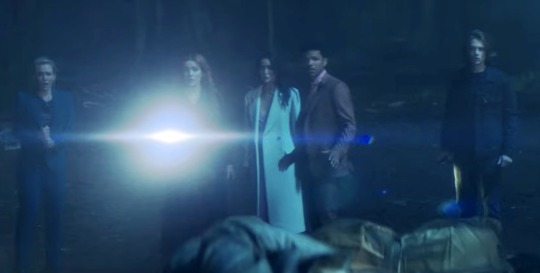
Speaking of Ace, the women are all dressed up while Ace is in another denim on denim look - is there an event where Nancy’s looking gorgeous but she doesn’t get to dance with Ace? GAH. We need a Nace slow dance in the worst way. Kennedy certainly hinted at Nancy’s agony at being at a party with Ace and not being able to interact with this tweet response to @sflcwers:

Now it’s possible the black dress is for the timey whimey prom Henry’s dressed for, and maybe the trailer’s demon scene is actually from episode 6 with some wardrobe holdover from 5, as they sometimes do.
My biggest question is - what the heck is Nancy holding in the trailer shot above? A magical MacGuffin that will help them fight the threat to the town? A weapon? A giant CHESS PIECE? It sort of looks like an oversized rook, and Kennedy previously gave us a chess EMOJI CLUE.

What if there’s some kind of chess-related mystery that relates to the sins of the past that they have to solve throughout the season? They have to find these chess pieces to save the town! Could it be something the Icarans planned from Icarus Hall? There’s quite a medieval fantasy theme going on with the crossbow, Nancy’s flower crown, and the Icarans sighting in Icarus Hall in the trailer.
OK, pure conjecture on my part, and the chess piece emoji could simply signify Game Night (which if so, yay!), but I LOVE a good mystical scavenger hunt a la the Horcruxes. I realize I may be going full on Beautiful Mind. Please give me your thoughts and theories in the comments/tags!
We still have those Icarans and spiders and proms and that NACE scene and Big Poppa Nancy to talk about, but these will have to wait for future posts as I’ve reached my photo limit here (sad). I’ll be back soon…
#nancy drew#nancy drew cw#ace [redacted]#nace#ndcw#nancy drew season 4#nancy drew s4#author: pluckysidekick
23 notes
·
View notes
Photo

MGM’s feature film Tarzan the Ape Man (1931), and its sequel, Tarzan and His Mate (1934), both starring former Olympic swimmer Johnny Weissmuller, turned out to be huge successes for the studio. They also cemented in the public’s mind the image of the monosyllabic, grunting ape man.
That iteration of the ape man was so popular that it was used in the non-MGM film serial Tarzan the Fearless (1933), starring another Olympic swimmer, Buster Crabbe.
Tarzan creator Edgar Rice Burroughs praised the films in public (they were making him money, after all), but privately hated their portrayal of his most prized creation. So he partnered with a family friend, Ashton Dearholt, and produced the 12 chapter-serial The New Adventures of Tarzan (1935).

The serial starred yet another Olympian, Henry Brix, in the title role. Ironically, Brix had been MGM’s first choice to play Tarzan in their films. Brix, unfortunately, broke his shoulder while filming another movie. MGM went with their second choice, Weissmuller, and the rest is history.
Frankly, just by physique alone I think Brix is the superior Tarzan. Even in his early films Weissmuller always looked a little doughy to me.
Brix’s Tarzan was also extremely faithful to the character from Burroughs’ novels: the cultured, educated, literate Lord Greystroke who spoke several languages, yet was unmistakably a man of action. This was the last time Tarzan would be depicted so until 1959′s Tarzan’s Greatest Adventure.

Once the troubled production was completed (and that story is practically a book in itself), movie theatres were offered two different was to exhibit the serial: as a stand-alone feature 70 minutes in length, entitled Tarzan and the Lost Tribe; or a feature-length (65 minutes) first episode, followed by the remaining 11 chapters.
Reviews of the film were generally poor in the US, and The New Adventures of Tarzan was the last Tarzan serial ever produced. However, like most Tarzan films of the time, it was a great success overseas. So much so, in fact, that in 1938 the last ten chapters of the serial were edited together to become the feature Tarzan and the Green Goddess.

Brix felt he was typecast after the serial was released, so he soon changed his name to Bruce Bennett. That’s how he’s billed in the numerous films and television episodes he appeared throughout the 1940s and 50s.
Some trivia regarding The New Adventures of Tarzan:
- The film was set, and largely filmed, in Guatemala.
- Producer Ashton Dearholt, who was married, met his leading lady, Ula Holt, on a previous trip to Guatemala. Dearholt was so smitten that he took Holt home to live with him. That promptly led Dearholt’s wife, Florence Gilbert, to leave with their two children and divorce him.
- Dearholt also played Raglan, the villain of the story. He claimed he had to step in to play the role when the actor hired for the part, Don Costello, got sick. This earns him the “George Santos Liar, Liar, Pants On Fire Award,” as there was no Don Costello. It was just a story Dearholt made up because he always planned to act in the film.
- Edgar Rice Burroughs fell in love with Dearholt’s ex, Florence Gilbert, when he first met her in 1929. During filming of the serial in 1935 Burroughs divorced his wife and married Gilbert, despite (or perhaps because) her being 30 years younger than him.
- Tarzan’s chimpanzee companion in the film was named Nkima, not Cheeta as in the MGM films. Jiggs the chimp played both roles, and he was paid $2,000 for his work in the serial.
- Herman Brix was hired at the salary of $75 a week but, other than his travel and accommodations in Guatemala, never got paid for his work.
- There are stories that Brix was personally chosen by Burroughs to play Tarzan. Brix himself stated that he only met Burroughs briefly after filming had wrapped. The only actor Burroughs actually picked for the role was Jim Pierce, for 1927′s Tarzan and the Golden Lion.
#The New Adventures of Tarzan#Tarzan#Herman Brix#Tarzan and the Green Goddess#Tarzan and the Lost Tribe#movie serials#Edgar Rice Burroughs
43 notes
·
View notes
Text
Who is the worst founding father?
Round 5: Thomas Jefferson vs Henry Clay

Thomas Jefferson (April 13, 1743 – July 4, 1826) was an American statesman, diplomat, lawyer, architect, philosopher, and Founding Father who served as the third president of the United States from 1801 to 1809. Jefferson was the primary author of the Declaration of Independence. Following the American Revolutionary War and prior to becoming the nation’s third president in 1801, Jefferson was the first United States secretary of state under George Washington and then the nation’s second vice president under John Adams.
Starting in 1803, he promoted a western expansionist policy with the Louisiana Purchase and began the process of Indian tribal removal from the newly acquired territory.
In confidential talks with French consul Joseph Létombe, Jefferson attacked President John Adams and predicted [he] would serve only one term, encouraged France to invade England, and advised Létombe to stall any American envoys sent to Paris by instructing him to “listen to them and then drag out the negotiations at length and mollify them by the urbanity of the proceedings." This toughened the tone that the French government adopted toward the Adams administration.
Jefferson lived in a planter economy largely dependent upon slavery, and used slave labor for his household, plantation, and workshops. Over his lifetime he owned about 600 slaves.
During his presidency, Jefferson allowed the diffusion of slavery into the Louisiana Territory hoping to prevent slave uprisings in Virginia and to prevent South Carolina secession. In 1804, in a compromise on the slavery issue, Jefferson and Congress banned domestic slave trafficking for one year into the Louisiana Territory.
In 1819, Jefferson strongly opposed a Missouri statehood application amendment that banned domestic slave importation and freed slaves at the age of 25 on grounds it would destroy the union.
Jefferson never freed most of his slaves, and he remained silent on the issue while he was president.
Since the 1790s, Jefferson was rumored to have had children by his sister-in-law and slave Sally Hemings, known as the Jefferson-Hemings controversy. According to scholarly consensus…as well as oral history, Jefferson probably fathered at least six children with Hemings.
---
Henry Clay Sr. (April 12, 1777 – June 29, 1852) was an American attorney and statesman who represented Kentucky in both the U.S. Senate and House of Representatives. He was the seventh House speaker as well as the ninth secretary of state. He unsuccessfully ran for president in the 1824, 1832, and 1844 elections. He helped found both the National Republican Party and the Whig Party. For his role in defusing sectional crises, he earned the appellation of the “Great Compromiser” and was part of the “Great Triumvirate” of Congressmen, alongside fellow Whig Daniel Webster and John C. Calhoun.
[Clay and his family] initially lived in Lexington, but in 1804 they began building a plantation outside of Lexington known as Ashland. The Ashland estate eventually encompassed over 500 acres (200 ha), with numerous outbuildings such as a smokehouse, a greenhouse, and several barns. Enslaved there were 122 during Clay’s lifetime with about 50 needed for farming and the household.
In early 1819, a dispute erupted over the proposed statehood of Missouri after New York Congressman James Tallmadge introduced a legislative amendment that would provide for the gradual emancipation of Missouri’s slaves. Though Clay had previously called for gradual emancipation in Kentucky, he sided with the Southerners in voting down Tallmadge’s amendment. Clay instead supported Senator Jesse B. Thomas’s compromise proposal in which Missouri would be admitted as a slave state, Maine would be admitted as a free state, and slavery would be forbidden in the territories north of 36° 30’ parallel. Clay helped assemble a coalition that passed the Missouri Compromise, as Thomas’s proposal became known. Further controversy ensued when Missouri’s constitution banned free blacks from entering the state, but Clay was able to engineer another compromise that allowed Missouri to join as a state in August 1821.
#semifinals!#founding fathers#worst founding father#founding father bracket#amrev#brackets#polls#thomas jefferson#henry clay
18 notes
·
View notes
Note
Any info on Louise Sébastienne? I’d like to know more about her :3
You mean Danton’s second wife? In that case, good question, but unfortunately not one I think has very exciting answers… Louise left no written material behind, nor could I find any letters adressed to her. All that we really have are documents briefly mentioning her.
Louise was born in Paris on March 3 1776. Her parents were Marc-Antoine Gély (1751-18) and Marie-Jeanne Léger Revel (1759-1825). According to Claude-François-Étienne Dupin (1767-1828) De la Révolution à la restauration, au service des administrés (2015) by Gildas Dacre-Wright, Louise was the youngest of three daughters. At the time of her marriage with Danton, she lived with her parents on the second floor of 24 of Cour de Commerce, a floor above her future husband.
When going through Danton biographies in order to find any info on Louise, three claims regarding the nature of their union continuously showed up. The first was that Louise knew the Dantons before marrying Georges, some saying her father Marc-Antoine had gotten into contact with Danton’s father by frequenting the latter’s café (Danton (1914) by Louis Madelin, Danton (1935) by Hermann Wendel), others that she was Gabrielle’s friend (Danton (1978) by Normann Hampson, Danton (1987) by Frank Dwyer). The second claim was that it was Gabrielle who begged the two to marry as a last wish (Life of Danton (1906) by Augustus Henry Beesly, Danton (1978) by Normann Hampson, Danton (1987) by Frank Dwyer and the third that Louise, being a religious person, was the one who asked for the ceremony to be officiated by a refractory priest (Danton (1914) by Louis Madelin, Danton (1978) by Normann Hampson, Life of Danton (1906) by Augustus Henry Beesly, Danton (1935) by Hermann Wendel). However, none of these could cite a primary source (or any source for that matter) for these claims, Augustus Henry Beesly going so far as to say ��There is a story that his first wife had recommended the marriage” and Norman Hampson that ”Gabrielle is said to have urged Louise Gély, a friend of the family and barely fifteen, to take care of her two boys. Louise is believed to have insisted, not merely on a religious marriage but on one celebrated by a priest who had refused to accept the revolutionary religious settlement.” So perhaps these are just apocryphal claims that hold themselves alive because no one bothers to check their origin properly.
Regardless, the marriage contract was passed on June 14 1793, in the presence of family members of the bride and groom. According to it, Louise received a dowry of 10 000 livres from her parents, along with 30 000 livres from Danton’s aunt Lenoir, to have if she was to survive her husband.
According to Danton, Mémoire sur sa vie privée (1865) Louise and Danton had a child together that died young, although I’ve not seen that claim repeated anywhere else…
On July 10 1794 a register was signed, handing custody of Danton’s two surviving children over to their maternal grandfather. Louise did not sign this paper, but her father did (perhaps only men could do it?). It’s hard to tell if Louise had taken care of her step-sons up until that point (that’s the conclusion drawn in Life in Revolutionary France (2020) by Mette Harder) or if they were taken in by their grandparents immediately and this was just a formal thing. It would nevertheless appear like Louise kept up contacts with Danton’s family. The paper L’Éclair wrote in 1895 that ”a correspondence (which I’ve not found any trace of) attests that Danton’s second wife and her father were still in contact with Danton’s sons and sister-in-law during the second empire.” Louise’s second husband, Dupin, had known the family before they married, and the godfather of the couple’s first surviving child may have been Danton’s brother-in-law François Victor Charpentier. Similarily, in 1812, Charpentier’s wife Constance painted a portrait of Louise (”Baronne Dupin”). Danton’s sons, however, couldn’t even get Louise’s name right in a memoir written 1846:
In the course of this same year, 1793, we cannot indicate the precise time, he (Danton) married, as his second wife, mademoiselle Sophie (sic) Gély, who was still alive two years ago (we do not know if she has died since).
On July 13 1795, Louise was present for the removal of seals for Danton’s old house, playing the role of Danton’s attorney general. According to the protocol she had at this point moved to Arcis-sur-Aube, where Danton’s mother also lived.
Louise got remarried to Claude-François-Étienne Dupin, by then chief secretary of the department of Seine, in 1796. They had a religious wedding ceremony on May 9 and a civil one the day right after. According to Claude-François-Étienne Dupin… (2015) the ceremony was presided over by abbé de Keravenant, who had also been in charge of the one between Louise and Danton. Louise’s father, along with four others, were the only witnessses. Louis Madelin claimed in his Danton (1914) to have received letters from people who knew Louise as an old woman, telling him that she disliked talking about Danton after remarrying.
The couple first settled down in Danton’s old apartment, but they would move around a lot in the years to come, starting two years later when they went to live at Rue du Théâtre français instead. Dupin, being appointed baron of the Empire in 1809, sometimes went on long missions, while Louise mostly stayed at home and gave birth to their children. In 1808 the family moved to Niort after Dupin was appointed there, whose Maternal Charity Society (whose goal it was ”to help poor women in childbirth, to provide for their needs and help with the breastfeeding of their children”) Louise became a member of in 1812. They moved back to Paris one year after that. Dupin died 1828 and Louise 28 years later, aged 80. Both were buried in the Montparnasse Cemetery.
Dupin and Louise had five children together, of which the two youngest lived to see adulthood, a girl, Camille Antoinette (born 1801) and a boy, Antoine Louis Gabriel (1804-1856). The latter married in 1832 and had a child fifteen years later, but after that his lineage seems to end. Camille on the other hand had a girl, Marie Bellot de Kergorre (1837-1884), who in her turn gave birth to the French author René de Laigue (1862-1942, who actually has his own wikipedia page). René had two daughters that died in 2002 and 2008 respectively. I can’t find any info on whether they had children or not, but if they did, it’s possible Louise still has descendants that are alive and kicking, and if not, she at least had not that long ago.
Since, as mentioned, Louise left no writings behind, I couldn’t find anything regarding the idea that she was a royalist, which is what’s claimed on wikipedia among other places.
20 notes
·
View notes
Text
youtube
Watch the American Climate Leadership Awards 2024 now: https://youtu.be/bWiW4Rp8vF0?feature=shared
The American Climate Leadership Awards 2024 broadcast recording is now available on ecoAmerica's YouTube channel for viewers to be inspired by active climate leaders. Watch to find out which finalist received the $50,000 grand prize! Hosted by Vanessa Hauc and featuring Bill McKibben and Katharine Hayhoe!
#ACLA24#ACLA24Leaders#youtube#youtube video#climate leaders#climate solutions#climate action#climate and environment#climate#climate change#climate and health#climate blog#climate justice#climate news#weather and climate#environmental news#environment#environmental awareness#environment and health#environmental#environmental issues#environmental justice#environment protection#environmental health#Youtube
17K notes
·
View notes
Text
The Canonical Five: Mary Ann Nichols

August 17, 2022
I’ve been not posting as much lately but I wanted to come back with a bang and do Jack the Ripper, one of my favourite true crime cases of all time. However, instead of just doing a post on the entire case I figured I’d do a deep dive into each of the victims.
I know Jack the Ripper most likely had more victims than just these five women, however the Canonical Five has become extremely infamous in this case and each woman deserves their own post in my opinion.
Here we go.
Mary Ann, also known as “Polly” to friends and family, was born Mary Ann Walker on August 26, 1845 in Dean Street, Soho, London. She was the second child of Edward and Caroline Walker.
At 18 years old Mary Ann married a man named William Nichols on January 16, 1864 at Saint Bride’s Parish Church in the City of London. The couple first lived at 30-31 Bouverie Street, but eventually moved In with Mary Ann’s father at 131 Trafalgar Street.
The couple had five children together: Edward John (born in 1866), Percy George (born in 1868), Alice Esther (born in 1870), Eliza Sarah (born in 1877) and Henry Alfred (born in 1879).
Shortly after their fifth child Henry was born, Mary Ann and William moved into their own home at 6 D-Block Peabody Buildings on September 6, 1880, paying a weekly rent. However, this did not last for long and the couple separated with William taking four of their children to live near Old Kent Road.
Mary Ann’s father accused William of leaving Mary Ann due to an affair he supposedly had with the nurse who had been there when their son Henry was born, though William claimed that him and Mary Ann had kept their marriage going for at least three years after this alleged affair. William insisted that the reason for their separation was due to Mary Ann’s heavy drinking and he had only started an affair after Mary Ann had left him. William had told authorities later on that Mary Ann had left him and began practicing sex work.
In 1881, Mary Ann was residing at Lambeth Workhouse, though she left this workhouse on May 31st. She did eventually return to the workhouse on April 24, 1882. She did move back with her father for a period of time in 1883 before moving out again following a quarrel.
Back in these days you legally had to support your wife, despite them being separated, William Nichols would pay Mary Ann a weekly allowance of five shillings until the spring of 1882, when he found out she was working as a sex worker. William stopped making these payments due to this, and explained to the authorities that his wife had deserted him and his family, living with another man and involved in sex work.
William was not required to pay his wife if she was earning money through sex work, so Mary Ann no longer was receiving anything from her husband.
The money Mary Ann did make from sex work was often spent on alcohol.
In April 1888, Mary Ann began working as a domestic servant to Mr and Mrs Cowdry in Wandsworth. However, this did not last long and she left after only working there for 3 months, stealing clothes with her when she left. She lived in a common lodging-house for a period of time before moving to 56 Flower and Dean Street in Whitechapel on August 24, 1888.
Around 11pm on August 30, 1888, Mary Ann was seen walking along Whitechapel Road. She visited the Frying Pan public house in Brick Lane, Spitalfields, leaving at 12:30am on August 31.
By 1:20am, she had returned to her lodging-house, and within the hour she was seen by the deputy lodging house keeper who asked her to pay for her bed for the night there. Mary Ann replied she had no money and she was ordered to leave. She said she would earn money and be back to get her bed.
The last time Mary Ann Nichols was seen alive was by a woman named Emily Holland, where she was seen walking alone down Osborn Street around 2:30am. She was notably drunk according to Emily and at one point was slumped against the wall of a grocery shop.
Emily had tried to get Mary Ann to go back to her lodging-house, but Mary Ann refused telling her she had already earned her money for the bed three times over but had spent it each time. The two parted with Mary Ann walking towards Whitechapel Road.
At 3:40am, a man named Charles Allen Cross found what he believed to be a tarpaulin lying on the ground in front of a gated stable entrance in Buck’s Row, Whitechapel as he was walking to his workplace. Inspecting closer, Cross discovered that it was actually the body of a woman who was laying on her back with her eyes open, her legs straight, and her skirt raised above her knees. Her left hand was touching the gate of the stable entrance.
Another man on his way to work, Robert Paul, saw Cross standing in the road looking at the body and both men examined the body together. Cross had touched the woman’s face which was still warm, then her hands which were cold. Cross thought the woman was dead, but Paul thought she might just be unconscious. The men pulled her skirt down and went to find a policeman. Constable Jonas Mizen was sent to examine the body while the men went on their way to work.
Before Mizen got there, another policeman, John Neil had come across the body and was using a lantern to examine. While he was doing this he got the attention of Constable John Thain who was passing the entrance to Buck’s Row, which Neil shouted, “Here’s a woman with her throat cut. Run at once for Dr Llewellyn.”
Neil found no blood trails with his lantern, and also examined the road but found no marks of wheels.
Surgeon Dr Llewellyn arrived at Buck’s Row at 4am and found two deep knife wounds on the woman’s throat, determining her deceased. The doctor determined she had only been dead for 30 minutes upon discovery, as her body and legs were still warm. He ordered Neil to take the body to the mortuary where he could then further examine her.
Police questioned all the tenants of Buck’s Row, including those who lived on the property closest to where the woman’s body had been discovered. Several residents claimed to be awake at that time but no one heard or saw anything. All police who had been patrolling around the area at that time also claimed to have seen nothing suspicious.
It was discovered that both sides of the woman’s face had been bruised by either a first or the pressure of a thumb before the throat wounds had been inflicted. One of the wounds measured 8 inches in length, and the other one measured to be 4 inches. Both reached back to her vertebral column and were inflicted from left to right.
The woman’s genitals had been stabbed twice, her abdomen mutilated with one deep, jagged wound 2 or 3 inches from the left side. Several incisions had been inflicted across the abdomen, causing her bowels to protrude through. Three or four similar cuts ran down the right side of her body. The knife used was estimated to be at least 6-8 inches long, possibly a cork-cutter or shoemaker’s knife.
Each wound had been violent and in a downward thrusting manner. The doctor believed that whoever did this had some kind of anatomical knowledge. None of the woman’s organs were missing.
Dr Llewellyn estimated that this would have taken the murderer 4-5 minutes to complete. He also believed the woman had been facing her attacker when he held his hand across her mouth before cutting her throat. She would have died instantly and all of her injuries were made by the murderer after she died. The doctor believed this because there was little blood.
The woman had no identification on her at the time of her death, and the only possessions she had was a white pocket handkerchief, a comb, and a piece of mirror. Her petticoats were marked “Lambeth Workhouse P.R.” so they believed that is where she resided. The matron of the workhouse could not identify the body, a workhouse inmate named Mary Ann Monk positively identified the woman as being Mary Ann Nichols at 7:30pm on August 31. Emily Holland had also positively identified her earlier that day.
On September 1, 1888, William Nichols corroborated this discovery as being his estranged wife, stating “I forgive you, as you are, for what you have been to me.”
The first day of the inquest heard testimony from three witnesses. The first was Mary Ann’s father, who claimed his daughter had been separated from William Nichols for about 7 or 8 years. He also said he had not seen his daughter since Easter and she had no known enemies.
Constable John Neil also testified, claiming the actual location of the murder was dimly lit, the closest light being a street lamp shining at the end of the row. Neil also said that Whitechapel Road was pretty busy even at the time of the discovery, so it’s possible that Mary Ann’s killer could have escaped in that direction.
Dr Llewellyn also testified, stating that Mary Ann had 5 missing teeth, a slight laceration on her tongue, a bruise running along the lower part of her jaw on the right side of her face. This could have been caused by a blow from a fist or pressure from a thumb. He further described her injuries and stated that no blood was found on the body or clothes. The injuries may have been done by a left-handed person and all of Mary Ann’s injuries had been done by the same instrument.
A man named Harry Tomkins testified that he had not left his place of work after 1am on August 31 and him and his colleagues did not hear anything suspicious. Tomkins said his workplace was very quiet, but said he was too far away from the crime scene to have been able to hear any cries for help.
Inspector Joseph Helson testified that Mary Ann had not been carried to the location where her body was found, she had been killed there.
William Nichols testified again and claimed to have not seen his wife in three years and that she had left him of her own accord because of her drinking. He stated he had no knowledge of his wife’s whereabouts in the years before her death.
It was determined that if Mary Ann’s murderer was walking around with blood on them after the attack, it would not have looked strange as this was Whitechapel in 1888 and many slaughterhouses were around. It wasn’t strange to see someone with blood on them during this period of time.
By the time the inquest was completed, another murder of similar nature had occurred, with a woman named Annie Chapman being murdered on September 8, 1888. Many consider her to be the second canonical five murder, and she also was found with similar bruising on her face and horrific injuries.
Mary Ann Nichols and Annie Chapman had a lot of similarities, both involved in sex work, being estranged from their husbands, and being around the same age. Annie Chapman’s murder will be discussed in further detail in the second instalment of this series.
A 20 minute deliberation took place, and the jury came back concluding that Mary Ann Nichols had been murdered perhaps by someone she didn’t know.
Mary Ann’s murder had occurred within 300 yards of two previous murders of two other women named Emma Smith and Martha Tabram. All of the murders had occurred within a 5 month period, but they were clearly different. What led many to believe they were committed by the same person was the geographical location, and some do believe that Emma Smith and Martha Tabram are Ripper victims, however many do not.
A reporter named Ernest Parke suggested in the August 31 edition of The Star, that these murders were committed by a single killer. Many others began to adopt this theory as well. In the week after the inquest closed on Mary Ann Nichols, two more women were murdered in similar fashion, Elizabeth Stride and Catherine Eddowes.
Any suspicions of a serial killer soon became confirmed as all of the women had been killed by a similar modus operandi, and eventually in October of 1888, the killer named himself Jack the Ripper.
Before any of this however, there was a rumour going around that a local Jewish man named John Pizer known as “Leather Apron” who made footwear from leather may have murdered the women. He was known to carry a knife and did not like sex workers.
There was no direct evidence against him but he was arrested on September 10, 1888. A search of his home was conducted where they found 5 long-bladed knives, however Pizer was soon released after confirmation of his alibis. He later received compensation from at least one newspaper who had named him a murderer.
Mary Ann Nichols was buried on September 6, 1888, with her father, estranged husband and three of her children in attendance. She was buried in the City of London Cemetery. Her coffin had a brass plaque with the inscription, “Mary Ann Nichols, aged 42; died August 31, 1888.”
Mary Ann Nichols is considered the first victim of the canonical five and many consider her the first Jack the Ripper victim. In the next part, the murder of Annie Chapman will be covered.
#unsolved#UNSOLVED MYSTERIES#unsolved case#unsolved murder#unsolved true crime#true crime#Crime#london#jack#the#ripper#victim
32 notes
·
View notes
Text
The Shadohunter Chronicles Character Showdown
First Round, Second Round
Auraline vs Kit Herondale, (Apr 28)
Max Lightwood vs Jessamine Lovelace, (Apr 29)
Isabelle Lightwood vs Gabriel Lightwood, (Apr 30)
Tessa Gray vs James Herondale, (May 1)
Raphael Santiago vs Irene, (May 2)
Julie Beauvale vs Robert Lightwood, (May 3)
Will Herondale vs Alastair Carstairs, (May 4)
Cecily Herondale vs Cristina Mendoza-Rosales, (May 5)
Henry Branwel vs Ty Blackthorn, (May 6)
Stephen Herondale vs Elyaas the Demon, (May 7)
Sona Carstairs vs Rosemary Herondale, (May 8)
Hypatia Vex vs Thais Pedroso, (May 9)
Anush Joshi vs Max Lightwood-Bane, (May 10)
Alexander Lightwood vs Simon Lovelace-Lewis, (May 11)
Dru Blackthorn vs Rafeal Lightwood-Bane, (May 12)
Cordelia Carstairs vs Helen Blackthorn, (May 13)
Jace Lightwood-Herondale vs Eugenia Lightwood, (May 14)
Grace Blackthorn vs Diego Rocío-Rosales, (May 15)
Charlotte Fairchild vs Chairman Meow, (May 16)
Rupert Blackthorn vs Matthew Fairchild, (May 17)
Cameron Ashdown vs Filomena di Angelo, (May 18)
Emma Carstairs vs Jia Penhallow, (May 19)
Beatriz Mendoza vs Kraig, (May 20)
Jordan Kyle vs Bridget Daly, (May 21)
Gideon Lightwood vs Alec Lightwood-Bane, (May 22)
Anna Lightwood vs Julian Blackthorn, (May 23)
Jem Carstairs vs Maryse Lightwood, (May 24)
George Lovelace vs Magnus Lightwood-Bane, (May 25)
Tavvy Blackthorn vs Barbra Lightwood, (May 26)
Aline Penhallow vs Sophie Collins, (May 27)
Clary Fairchild vs Christopher Lightwood, (May 28)
Zachary Carstairs vs Lily Chen, (May 29)
#shadowhunters#the shadowhunter chronicles#tsc#the dark artifices#tda#the mortal instruments#tmi#the last hours#tlh#the wicked powers#twp#tid#the infernal devices#shadowhunter character showdown 2024
12 notes
·
View notes
Text
24 Days of La Fayette: December 10th - George Augustine Washington
Todays Aide-de-camp is the nephew of George Washington – and one of his favourite nephews as well. George Augustine was born around 1759 to George Washington’s youngest brother Charles Washington and his wife Mildred Thornton Washington.
While not much about the early years of George Augustine is known, his service in the American War of Independence is very well documented.
He joined the army in 1777 and was initially offered a junior officer’s commission in William Grayson’s Additional Continental Regiment. George Augustine declined in favour of an equal position in the prestigious corps of light horse. In 1778 he was made a coronet in the partisan legion under the command of Major Henry Lee. During this period of his life, young Washington’s health began to seriously suffer for the first time – in the course of the coming years he sometimes enjoyed better, sometimes worse health, but he would never again fully recover, and he died at a young age. By the end of 1778 he was forced to resign his post due to this illness. In the summer of 1779, he was well enough to serve as a volunteer aide-de-camp to General George Washington. On February 16, 1780, he was on duty with the Commander-in-Chief’s Guard. By mid-1780, La Fayette had been given command of a light infantry division and George Augustine Washington joined the Marquis’ staff as an Aide-de-camp.
George Washington Augustine is only seldomly mentioned in La Fayette’s letters, but it can nevertheless be judged, that the two of them had a close relationship and that La Fayette trusted Washington with important tasks. It also appears that Washington got quite well along with the other officers in La Fayette’s staff and the other (foreign) officers.
La Fayette wrote to the Vicomte de Noailles on September 2, 1780:
MM. Washington and Gimat send you a thousand compliments, and I embrace you.
Vol. 3, 156-159
Although his illness, today believed to be tuberculosis, again flared up during this time, he was very active during the Siege and following Battle of Yorktown. Upon La Fayette’s second return to France in 1781, George Augustine returned to the staff of his uncle before resigning once and for all in the spring of 1782 due to his deteriorating health. George Augustine spend much of the following three years travelling to the southern parts of the United States as well as abroad to Bermuda and Barbados in search of a cure for his ailments. In May of 1785, he had returned to his native Virginia and promptly proposed to Frances “Fanny” Bassett. The pair was married on October 15, 1785 and initially moved in with George and Martha Washington. In 1786, George Augustine and Fanny were gifted more than 200 acres of land from George Washington to start their own family there.
Charles Washington, son of Augustine & Mary, married Mildred Thornton, daughter of Colonel Francis Thornton of Spotsylvania County, by whom he has four Children, George Augustine, Frances, Mildred & Samuel. George Augustine married Frances Basset, daughter of Colo. Burwell Basset of New Kent by whom he has had four Children, three of whom are living—viz.—Anna Maria, George Fayette, & Charles Augustine. Frances, married Colo. Burgess Ball by whom she has had several children. Mildred and Samuel are unmarried.
“Enclosure: Washington Genealogy, 2 May 1792,” Founders Online, National Archives, [Original source: The Papers of George Washington, Presidential Series, vol. 10, 1 March 1792 – 15 August 1792, ed. Robert F. Haggard and Mark A. Mastromarino. Charlottesville: University of Virginia Press, 2002, pp. 334–338.] (09/30/2022)
By autumn of 1785, George Augustine had begun managing his uncle’s estate Mount Vernon. He was taught the ropes by Washington himself and in later years, when Washington’s call to public service led to longer absences, undertook more and more responsibility. George Augustine was a military man, accustomed to duty and discipline – sentiments that leaked into his managing-style and were often remarked upon. Here is a sample of George Augustine's handwriting from his plantation records (work and weather report) from October 27, 1792:

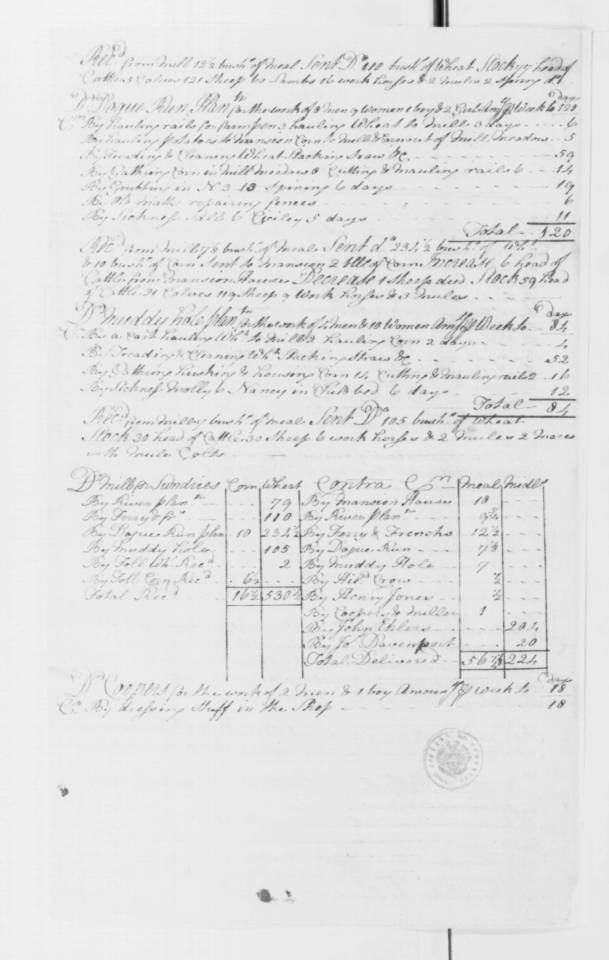
George Washington Papers, Series 4, General Correspondence: George Augustine Washington, Plantation Records: Work and Weather Report. 1792. Manuscript/Mixed Material. Retrieved from the Library of Congress. (10/19/2022)
George Augustine missed La Fayette’s return to the United States in 1784 and subsequent visit to Mount Vernon by a few days but wrote to his uncle on August 14, 1784:
(…) should my worthy friend the Marquis be with You I beg to be rememberd to him in the most friendly terms. I should have wrote Him but apprehending from a peeice of information I recieved from a person immediately from Philadelphia, that He had not accomplished His visit, He mentiond that accounts had been recieved of His having saild but from a desaster that befel the Vessel He was obliged to return (…)
“To George Washington from George Augustine Washington, 14 August 1784,” Founders Online, National Archives, [Original source: The Papers of George Washington, Confederation Series, vol. 2, 18 July 1784 – 18 May 1785, ed. W. W. Abbot. Charlottesville: University Press of Virginia, 1992, pp. 39–41.] (09/30/2022)
His health had been long suffering. His bodily state became so worrisome, that George Washington felt prompted to write the following lines to Tobias Lear on September 21, 1792:
Poor George! He is, I believe not far from that place, from whence no traveller returns. He is but the shadow of what he was; he has not been out of his room & scarcely from his bed these six weeks. At times he has intervals of ease which flatter a little, but I have little hope of his surviving the Winter.
“From George Washington to Tobias Lear, 21 September 1792,” Founders Online, National Archives, [Original source: The Papers of George Washington, Presidential Series, vol. 11, 16 August 1792 – 15 January 1793, ed. Christine Sternberg Patrick. Charlottesville: University of Virginia Press, 2002, pp. 133–135.] (09/30/2022)
George Washington also wrote to the Marquis de La Fayette on June 10, 1792:
I am afraid my Nephew George, your old aid, will never have his health perfectly re-established, he has lately been attacked with the alarming symptom of spitting large quantities of blood, and the Physicians give no hopes of a restoration unless it can be effected by a change of air, and a total dereliction of business (to which he is too anxiously attentive he will, if he should be taken from his family & friends, leave three fine child:—viz.—two Sons & a daughter—the eldest of the boys he has given the name of Fayette to and a fine looking child he is).
“From George Washington to Lafayette, 10 June 1792,” Founders Online, National Archives, [Original source: The Papers of George Washington, Presidential Series, vol. 10, 1 March 1792 – 15 August 1792, ed. Robert F. Haggard and Mark A. Mastromarino. Charlottesville: University of Virginia Press, 2002, pp. 446–448.] (09/30/2022)
There have actually been two children named Fayette. Two boys were named George Fayette Washington, but the older son only lived for a few short weeks. The younger son, born on January 17, 1790, died on August 6, 1867.
George Augustine Washington himself died on February 3, 1783. His death hit George Washington hard. He wrote to David Humphreys on March 23, 1783:
(…) and the death of my Nephew, the poor Major, will, I apprehend, cause my private concerns to suffer very much. This melancholly event took place on the 5th of last month at Colo. Bassett’s, where he had gone hoping to benefit from a change of air & situation—Altho’ it had been long expected—and indeed, to me, of late, appeard inevitable; yet I have felt it very keenly.
“From George Washington to David Humphreys, 23 March 1793,” Founders Online, National Archives, [Original source: The Papers of George Washington, Presidential Series, vol. 12, 16 January 1793 – 31 May 1793, ed. Christine Sternberg Patrick and John C. Pinheiro. Charlottesville: University of Virginia Press, 2005, pp. 362–364.] (09/30/2022)
On April 9, 1783, George Washington wrote to Bryan Fairfax about his nephew’s funeral service:
At One ’oclock afternoon on Thursday next, I mean to pay the last respect to my deceased Nephew—by having the funeral obsequies performed.
If you will do me the favor to officiate on the occasion, it will be grateful to myself, & pleasing to other friends of the deceased. No Sermon is intended, and but few friends will be present; for these dinner will be ready at half after two Oclk, at which I should be happy & shall expect to see you.
“From George Washington to Bryan Fairfax, 9 April 1793,” Founders Online, National Archives, [Original source: The Papers of George Washington, Presidential Series, vol. 12, 16 January 1793 – 31 May 1793, ed. Christine Sternberg Patrick and John C. Pinheiro. Charlottesville: University of Virginia Press, 2005, p. 442.] (09/30/2022)
The service was performed on April 11, 1793.
La Fayette had been caught up in the French Revolution at the time of George Augustine’s death and only much later learned of the young man’s death. He wrote to George Washington after his release from prison on May 9, 1799:
George had on his return from America acquainted me with the melancholy news that my Dear aid de Camp, your worthy nephew was no more—I heartily feel the affectionate attention he had to call after me his eldest Boy—my tenderest wishes shall ever attend what remains of that excellent Man.
“To George Washington from Lafayette, 9 May 1799,” Founders Online, National Archives, [Original source: The Papers of George Washington, Retirement Series, vol. 4, 20 April 1799 – 13 December 1799, ed. W. W. Abbot. Charlottesville: University Press of Virginia, 1999, pp. 54–59.] (09/30/2022)
George Augustine’s widow went on to marry Tobias Lear, George Washington’s private secretary, in 1795 before dying herself of tuberculosis in 1796.
#marquis de lafayette#24 days of la fayette#lafayette's aide-de-camps#french history#american history#american revolution#history#letter#la fayette#founders online#charles washington#george augustine washington#1777#1778#1779#1780#1784#1785#1792#1793#georges washington de lafayette#tobias lear#library of congress#handwriting
13 notes
·
View notes
Text
Dollar Bin #4:
Emmylou Harris's Angel Band

I visited four different Iowa record stores while dropping my second born off at college last week and I have much to report.
Yes, there are at least four record stores in the state. The mystery is how they stay open.
Emerson, Lake and Palmer records are deemed worthy of plastic protection in Iowa, and $25 Yes records come with handwritten stickers that say things like "Side 1 Skips!" followed by a frownie face. These stores are convinced - convinced! - that newly printed Guns and Roses records deserve places of high honor up on the wall and that Jerry Jeff Walker belongs in folk rock. After all, the Country section is behind a wall of dangling beads and George Jones fills an entire crate.
A rotund, nose-ringed salesdude nods when you enter, drops the store's diamond needle on Bad to the Bone, then ambles over to offer you a tour "of their whole set up" while bragging about the minty, clear vinyl, limited edition Blink 52 record they just scored for $75 even though it's worth $300, easy.
I was happy for the dude, I really was, but I shook them off, strode past a pickle barrel of still cellophaned tapes (4 for $5!) and found that their Neil Young section was - I swear to god - entirely empty.
Is that even legal? I mean can you really own a record store and not have a single Neil Young record? And how, you ask, are such stores even in business?
I'll tell you how: at one of them I found, after 30 years of earnest hunting, my first ever copy of Henry the Human Fly (it was an original Reprise print no less, and even though I could really give a flying turd about such things - this is the Dollar Bin after all, not Nathan's VGG++ Nerd World - I was still pretty damn fired up and almost hugged the salesdude). Anyway, I snapped up that little blue number for the very non-Dollar Bin price of 37 bucks, thereby keeping that store in business long enough for them to blast George Thorogood for another glorious day. B-B-B-B-Bad!
All kidding aside, the people of Iowa are amazing. At stop signs drivers wave to one another! Please pack up all spare copies of your favorite records, drive to Iowa, and donate them to those lovely people.
I don't know about you, but every time I enter a new record store for the first time I head straight to Young, Neil and start judging the place. I don't really expect to find anything by Neil that I don't already have - but please, God, please help me find a copy of Ragged Glory someday, and please make it cost less than $50; I don't ask for too much God but this one favor I do of you most humbly implore - but Neil's section is an easy and effective way to find out if the store is worth my time. Or yours.
If there's nothing to be found other than a $22 copy of Comes a Time, or even worse, nothing but an already dusty, year-old copy of Noise and Flowers for $65, I know I'm better off at Chili's eating a bloomin onion alone; if they have nothing but copy after copy of Re-ac-tor, Time Fades Away and Journey Through the Past, I stay open minded - maybe ten minutes earlier they sold a crunchy old copy of On The Beach; and if they have Old Ways or Trans for $8-10 it's time to get excited and explore the store.
Stop #2 for me in any new record store is always Emmylou Harris. I submit for your consideration the following thesis: a good record store should have on stock most, if not all, of her records between Gliding Bird (1970) and Bluebird (89). We're talking about something like 15 titles between those bookends, and all of them should be in any good record store for under 8 bucks a piece.
Don't get me wrong: these records should not be cheap given their quality. I am hear to tell you that Emmylou Harris does not make bad, or even mediocre records. Like Paul Simon (well, there is Songs from The Capeman...), she only releases good albums. The same cannot be said for Neil or Bob, though I love them dearly. I defy even my famous brother to find an argument for Down in the Groove or The Monsanto Years.
(For those at home taking notes: I did indeed make the statement in an earlier post that Neil can do no wrong. I stand by that statement! Dylan and Young alike put out crap intentionally. It's what genius's do, people! Come to think of it, that's why some (maybe all!) of my posts are gonna suck. Neil, Bob and I are simply shaking off any fair weather fans.)
But back to Emmylou: why, you ask, should every record store worth its salt have all her records cheaply in stock?
Consider:
A) between 75 and 89 she put out a record a year, all of them good, and sold them consistently to my mother and all my mother's friends and all my mother's friends' friends and... you get the idea: that's a lot of records;
B) all those women have, since they made those purchases, got a life. Unlike me. They don't need their records anymore and they've told their loser sons to put down their bongs and go out and do something with all their old vinyl in the hopes that the sons will learn entrepreneurship and decency in the process. Those loser sons have, in turn, not ignored their mother and listened to the Emmylou Harris records (like they should have!) but instead taken them to their local Treasured Vinyl and exchanged them for autographed copies of Roll the Bones, or some other comparable crap;
C) unlike her friend Dolly Parton, Emmylou has no amusement park to call home, nor any lifetime movies made in her honor; and, finally,
D) unlike Fleetwood Mac, no boyband applicant on a skateboard drinking juice has destroyed the internet with one of her songs as a soundtrack, thereby unleashing hoards of hipster kids to demand of all the local rotund record store dudes copies of Rumors.
Put all that together friends, apply a little supply and demand, and what do you get? Record stores should be full of cheap and outstanding Emmylou Harris records.
So let's focus in on one of my favorites and one that I bet none of you have ever listen to, Angel Band.
There's no getting around it, I have to tell you: Angel Band is a Jesus record.
Don't panic! You haven't been lured in here to be told that He Gets You. Instead, it's time for this entry's second thesis: Angel Band is The Best Jesus Record (by a white person, anyway).
That's right, it's better than Saved, Jesus Was a Capricorn, My Mother's Hymn Book and everything Van the 80's Jesus man ever put out. By far! Indeed, I'd even go so far as to argue that while listening to Angel Band you will forget altogether that the man from Galalee is even involved.
Before I preach the word of Emmylou, let's listen to the opening track.
youtube
I kinda feel like I could just end this entry right here. What can anyone possibly say other than Jesus Christ! The barely there but perfect band creates simple and delicious space around Harris' aching goddess of a voice. If some jerk doctor ever tells me I need to stop drinking beer (dear God, I'm back! Never mind my earnest appeal for Ragged Glory. Rather, God, please avert that hateful beerless future!), then I'm gonna have to listen to this album every day just to calm the hell down.
My prime hobby in life (good news everyone: as of this morning this blog is my day job because, thanks to my famous brother, I now have like 16 followers and surely that means cash money is coming my way, yes? Isn't that how the world wide web works? Siri, where's my paycheck?!) is teaching High School English and History; in that role I teach a four week block each year on The Holy Books.
The class is easy to teach even though I'm not a regular church goer; tell cool teens about Muhammad getting seized by the Angel Gabriel, back that up by showing them that Abraham is everyone's mythical great-grandad and they are all in. But, given the fact that Donald Trump and Samuel Alito continue to exist and threaten all our lives, Jesus is a tough sell to teens. (See that? Right there I'm not shaking off any new fair weather fans; I'm telling any Trump people reading this to go away and stop acting like shitheads.)
I do what I can in my Holy Books course to salvage Christianity: we get to the good stuff within the Sermon on Mount and St. John's Prelude and we separate St. Augustine's hateful nonsense from the essence of Christ. But the turning point, the moment when smart, open-minded kids realize that Jesus is about love without exception, not hate, often comes not through the texts or through my earnest lectures, but instead when I play them them The Stanley Brothers Angel Band or The Louvin Brothers I See A Bridge. No spiritual teaching that leads to such beauty could be altogether with merit, and kids get that.
youtube
Just about any song on Angel Band could win that same argument, including Harris' version of the title track. Covering a song that is perfect to begin with is either a brilliant move (see Dark End of the Street, originally by James Carr, and the versions by Linda Ronstadt and Richard and Linda Thompson), shrugable (Neil Young singing If You Could Read My Mind) or intolerable and gross (Stephen Stills' version of The Loner - I curse thee Stephen Stills!). But as far as I'm concerned Emmylou Harris could cover anything, from Will to Love to Love Shack, and make it great.
So get over your fear of Jesus, dive into your local dollar bin and relax while listening to Angel Band. God, if we are lucky, exists. And she sings just like Emmylou Harris.
6 notes
·
View notes
Text
youtube
Watch the 2024 American Climate Leadership Awards for High School Students now: https://youtu.be/5C-bb9PoRLc
The recording is now available on ecoAmerica's YouTube channel for viewers to be inspired by student climate leaders! Join Aishah-Nyeta Brown & Jerome Foster II and be inspired by student climate leaders as we recognize the High School Student finalists. Watch now to find out which student received the $25,000 grand prize and top recognition!
#ACLA24#ACLA24HighSchoolStudents#youtube#youtube video#climate leaders#climate solutions#climate action#climate and environment#climate#climate change#climate and health#climate blog#climate justice#climate news#weather and climate#environmental news#environment#environmental awareness#environment and health#environmental#environmental issues#environmental education#environmental justice#environmental protection#environmental health#high school students#high school#youth#youth of america#school
18K notes
·
View notes